Ademco 8DL6280ZW Tuxedo Touch WIFI User Manual 800 10300 A ii 6280 WiFi
Honeywell International Inc. Tuxedo Touch WIFI 800 10300 A ii 6280 WiFi
Ademco >
Contents
- 1. Users Manual Install and Setup Revised
- 2. Users Manual User Revised
- 3. Users Manual Install Setup Revised
Users Manual Install Setup Revised
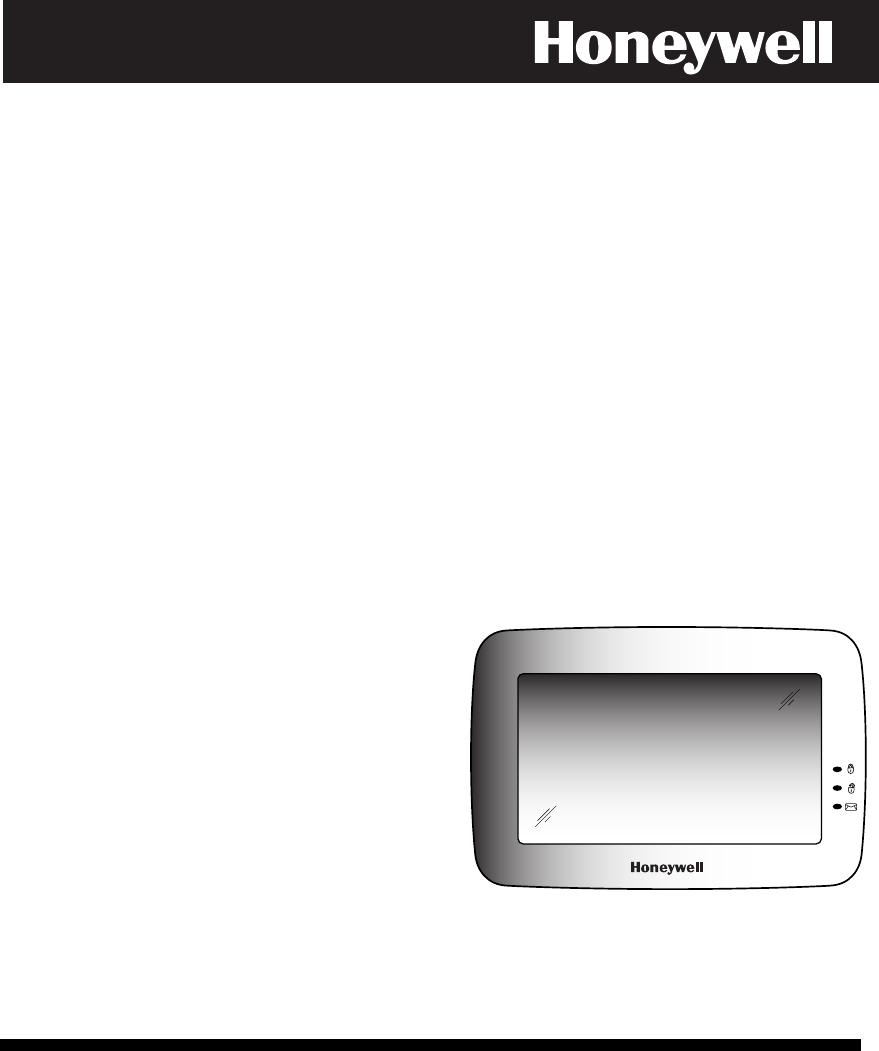
800-10300 11/17/11 Rev. A
B
BB
B
B
BB
BE
EE
E
E
EE
ET
TT
T
T
TT
TA
AA
A
A
AA
A
T
TT
T
T
TT
Tu
uu
u
u
uu
ux
xx
x
x
xx
xe
ee
e
e
ee
ed
dd
d
d
dd
do
oo
o
o
oo
o
T
TT
T
T
TT
To
oo
o
o
oo
ou
uu
u
u
uu
uc
cc
c
c
cc
ch
hh
h
h
hh
h
W
WW
W
W
WW
WI
II
I
I
II
IF
FF
F
F
FF
FI
II
I
I
II
I
H
HH
H
H
HH
Ho
oo
o
o
oo
om
mm
m
m
mm
me
ee
e
e
ee
e
A
AA
A
A
AA
Au
uu
u
u
uu
ut
tt
t
t
tt
to
oo
o
o
oo
om
mm
m
m
mm
ma
aa
a
a
aa
at
tt
t
t
tt
ti
ii
i
i
ii
io
oo
o
o
oo
on
nn
n
n
nn
n
S
SS
S
S
SS
Sy
yy
y
y
yy
ys
ss
s
s
ss
st
tt
t
t
tt
te
ee
e
e
ee
em
mm
m
m
mm
m
Installation and
Setup Guide
FCC / IC STATEMENTS ARE ON PAGE 47
<- OR USE THE BOOKMARK

Table of Contents
iii
About the System............................................................................................................................5
Safe Mode ......................................................................................................................................... 5
Compatibility.................................................................................................................................... 5
Software Upgrades .......................................................................................................................... 6
Mounting .......................................................................................................................................... 7
Wiring ............................................................................................................................................... 8
Specifications ................................................................................................................................... 9
Front Panel LEDs ........................................................................................................................... 10
Navigation Icons ............................................................................................................................. 10
Panel Fault Displays ...................................................................................................................... 12
Initial Setup .....................................................................................................................................13
Programming the Control Panel.................................................................................................... 13
Keypad Initialization...................................................................................................................... 13
Time and Date Setup...................................................................................................................... 13
Night Setup ..................................................................................................................................... 14
IP Setup and Network Connections............................................................................................... 14
Account Setup ................................................................................................................................. 16
Setup................................................................................................................................................17
Brightness and Volume Control..................................................................................................... 17
Display & Audio Setup ................................................................................................................... 17
Operating Modes............................................................................................................................. 17
Adjust the Screen Timeouts ........................................................................................................... 18
Clean Screen ................................................................................................................................... 18
Multi-Media......................................................................................................................................19
Picture Setup................................................................................................................................... 19
Camera Setup.................................................................................................................................. 20
Video (Audio) Setup ........................................................................................................................ 22
System Setup..................................................................................................................................23
CS Setup .......................................................................................................................................... 23
ECP Address Selection ................................................................................................................... 23
CS Options / Operating Modes....................................................................................................... 24
Operating Modes............................................................................................................................. 24
Screen Security ............................................................................................................................... 25
Code Authority ................................................................................................................................ 26
Device Events.................................................................................................................................. 26
Panel Configuration........................................................................................................................ 26
User System Setup......................................................................................................................... 27
User Setup....................................................................................................................................... 27

Table of Contents (cont’d)
iv
How to Add an Existing User to a Second Keypad....................................................................... 28
How to Delete a User...................................................................................................................... 28
Time/Date Setup ............................................................................................................................. 29
Setting Daylight Savings Time...................................................................................................... 29
Setting Current Time and Date ..................................................................................................... 29
System Information ........................................................................................................................ 30
Keypad Reset................................................................................................................................... 30
Advanced Setup .............................................................................................................................. 30
Keypad Test..................................................................................................................................... 30
LED Test ......................................................................................................................................... 31
Calibration Test .............................................................................................................................. 32
Z-Wave Test..................................................................................................................................... 32
NIGHT Setup Function .................................................................................................................. 33
Output Setup Function................................................................................................................... 33
Automation .....................................................................................................................................34
Including/Adding Z-Wave Devices .................................................................................................34
Include/Add a Light, Switch or Outlet Module ............................................................................. 34
Include a Door Lock ........................................................................................................................ 35
Include a Honeywell Thermostat................................................................................................... 35
Editing Z-Wave Device Names ...................................................................................................... 36
Edit a Device Module Name........................................................................................................... 36
Exclude/Delete Z-Wave Devices..................................................................................................... 36
Exclude a Light, Outlet, or Switch Module................................................................................... 36
Exclude a Door Lock Device ........................................................................................................... 36
Exclude a Honeywell Thermostat..................................................................................................37
Exclude All Z-Wave Devices........................................................................................................... 37
Abort a Z-Wave Action.................................................................................................................... 37
Output List...................................................................................................................................... 38
Create a Scene................................................................................................................................. 38
Create a Group................................................................................................................................ 40
Setting a Secondary Controller...................................................................................................... 40
Updating Controllers with New or Removed devices................................................................... 41
Removing a Secondary Controller .................................................................................................41
Z-Wave Troubleshooting................................................................................................................. 41
Compatible Devices......................................................................................................................... 42
Important Notes..............................................................................................................................43
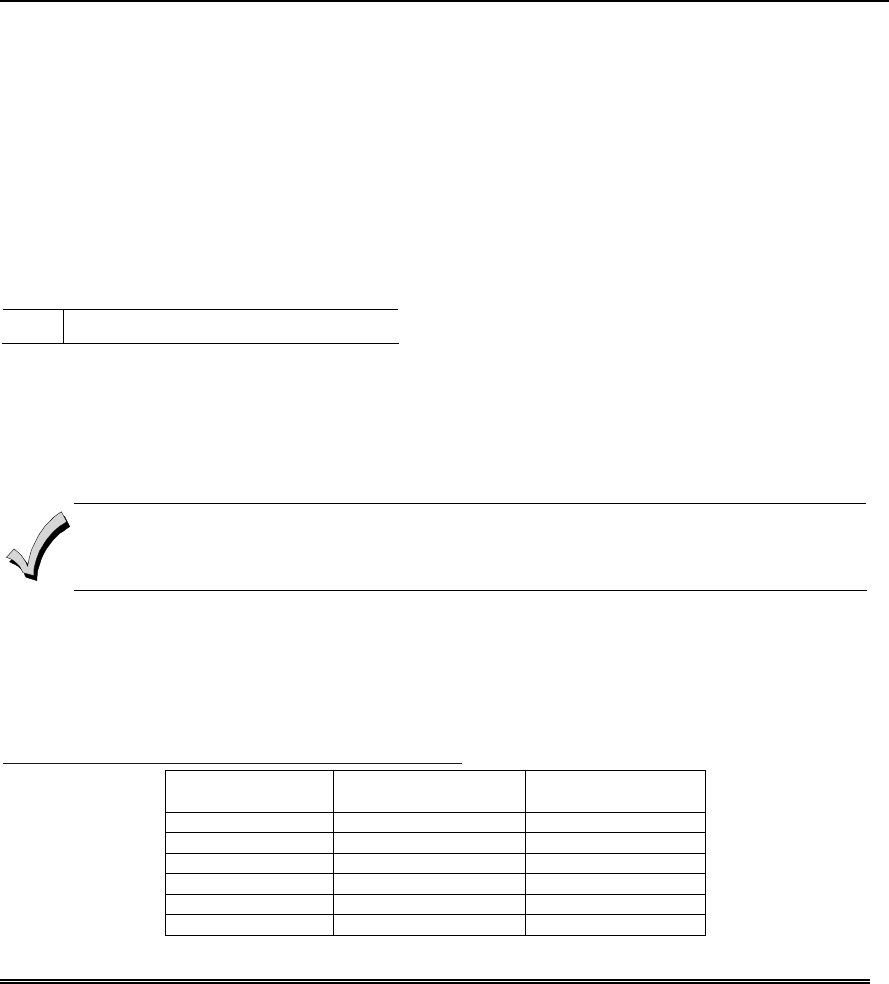
5
About the System
This guide provides information to install and set-up Honeywell’s Tuxedo Touch WIFI Home
Automation and Security System. The graphical touch-screen keypads are Advanced User Interface
(AUI) devices, which combine wireless home automation and security. Your system may consist of one
or more of the following:
• TUXWIFIS Keypad (silver housing)
• TUXWIFIW Keypad (white housing)
• One or more other keypads for system control
• Various sensors for perimeter and interior burglary protection, plus a selected number of
strategically placed smoke, carbon monoxide or combustion detectors
• Lighting/output devices.
Equipped with wireless capability and built-in Z-Wave technology, the Tuxedo Touch wireless keypad
can be used to control the home environment, such as lights, appliances, thermostat, door locks and
cameras via any web enabled device (PC, Smart Phone and Tablet).
UL Wi-Fi has not been evaluated by UL.
Note: To the installer, see the "Important Notes" in the
Important Notes
section of this guide.
Safe Mode
The keypad contains a Safe Mode of operation. In the rare event that the keypad cannot successfully
communicate in its graphic mode with the control panel, the Safe Mode is a backup mode that ensures
that you can communicate with your system. In this mode, the keypad operates much like a standard
non-graphic keypad so that you can control your system until the problem is corrected.
• DO NOT perform panel programming while in the Safe Mode. Performing panel programming
while in the Safe Mode may cause the panel and keypad to become out of sync.
• DO NOT use several hardwired motion detectors in high traffic locations. The high quantity of
signals received by the panel may cause the keypad to enter the Safe Mode.
Compatibility
The below listing identifies the alarm systems that the keypad can interface with, the maximum
number of keypads that can be used with each system, and the minimum alarm panel software revision
level for compatibility.
Note: For SIA installations used with a VISTA-128BPTSIA Control, see the SIA CP-01 Quick
Reference Chart, Document # 800-09699 located at:
http://www.security.honeywell.com/hsc/resourses/MyWebTech .
Alarm System
Maximum Number of
Keypads
Minimum Software
Revision Level
VISTA-15P 2 3.0
VISTA-20P 2 3.0
VISTA-20P 4 5.0
VISTA-21IP 4 1.0
VISTA-128BP 3 3.2
VISTA-128FBP 3 3.0

About the System (cont’d)
6
Alarm System
Maximum Number of
Keypads
Minimum Software
Revision Level
VISTA-128FBP-9 3 4.1
VISTA-250FBP-9 3 4.1
VISTA-250BP 3 2.4
VISTA-250FBP 1 3.0
VISTA-250FBP 3 2.0
VISTA-128BPE 3 4.4
VISTA-250BPE 3 4.4
VISTA-128BPEN 3 7.0
VISTA-128BPLT 3 6.0
VISTA-128FBPN 3 5.1
VISTA-128BPT 6 10.1
VISTA-250BPT 6 10.1
VISTA-128BPTSIA 6 10.1
FA148CP 2 3.0
FA168CPS 4 5.0
FA1660C 3 3
FA1660CT 6 10.1
FA1670C-9 3 4.1
FA1700C 3 3
Note: Keypad may only be used in the following UL/cUL installations: UL 365, UL609, UL 985, UL1023,
UL 1610, CAN/ULC-S303, CAN/ULC-S304, ULC-S545, ULC/ORD-C1023, and ANSI/SIA CP-01-2010.
• On all panels except the residential panels, you may obtain the software revision level of the
alarm panel by entering the program mode and then entering #92 on the keypad. This can be
done from the Console Mode or a standard alpha keypad, if supplied. The second line of the
keypad displays the software revision level (w/out the decimal point).
• The keypad sound suppression feature available in some commercial panels is not compatible
with the Tuxedo Touch keypad.
• The ‘Voice Chime’ feature is a residential control feature only.
Note: If using the maximum number of keypads, an additional auxiliary power supply may be needed.
Software Upgrades
IMPORTANT: During the installation process, check the latest software version and if necessary go to
MyWebTech to download the latest upgrade for your specific keypad model.
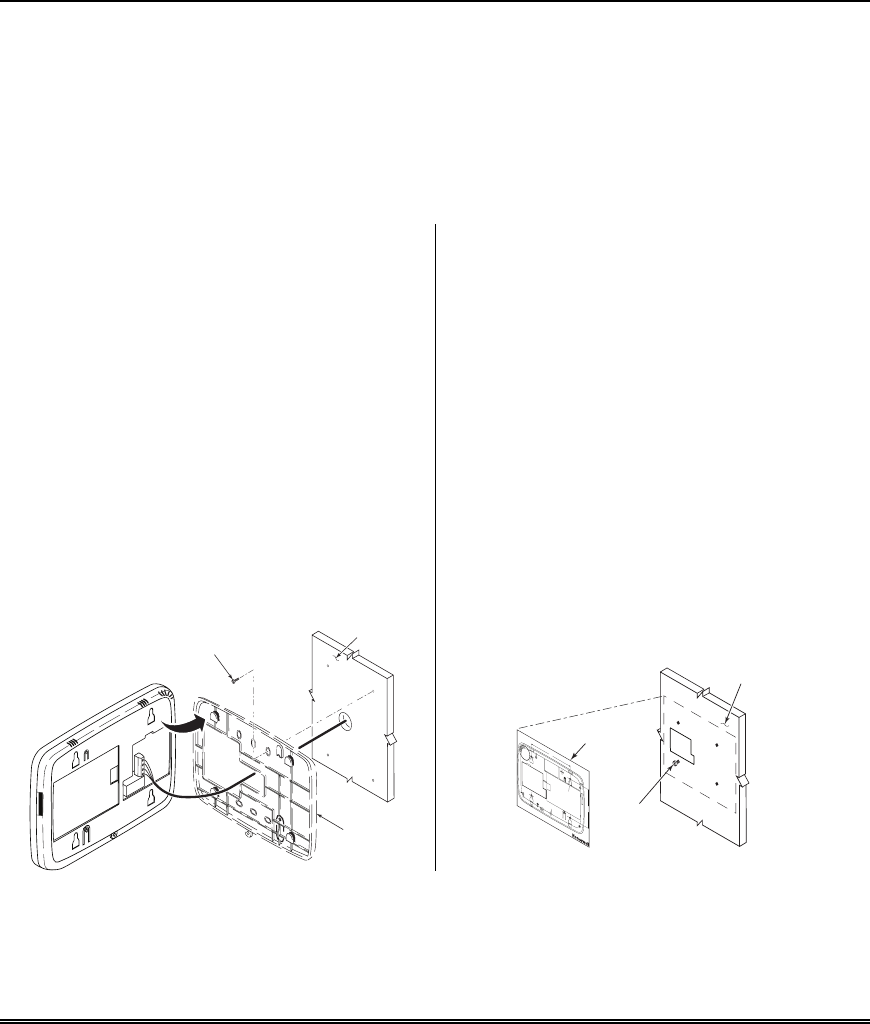
About the System (cont’d)
7
Mounting
This keypad is for indoor use only and should be mounted at a comfortable viewing level. Avoid
mounting in areas of high condensation such as bathrooms or in locations where bright light or
sunlight shines directly on the screen.
An optional Accessory Kit is available for desk mounting: Part No. TUXWIFIS-DM (Silver) or
TUXWIFIW-DM (White).
The keypad can be mounted with or without the mounting plate. Use the center securing screw for
European installations.
Standard Mounting with mounting
plate:
1. Select a mounting location.
2. Detach the mounting plate by sliding
downward.
3. Use the mounting plate to mark the location of
the mounting holes on the mounting surface
and check for level.
4. Locate the mounting plate over the mounting
surface such that the wire/cable access
openings are aligned while passing the
wires/cable through the case back.
**Go to “Wiring” (next page) and complete
wiring**
5. Secure the mounting plate to mounting surface
using 4 screws (supplied).
6. Slide keypad onto mounting plate.
6280-006-V0
WALL
SURFACE
WALL
MOUNTING
PLATE
(OPTIONAL)
MOUNTING
SCREWS (4)
(TYP)
Mounting without mounting plate:
1. Select a mounting location.
2. Detach the mounting plate by sliding
downward and discard.
3. Use the template (provided in the carton) to
mark the location of the mounting screws and
the cut-out for the keypad assembly on the
mounting location. Check for level.
4. Install 4 screws (supplied) in the mounting
surface leaving screw heads 1/8” above the
mounting surface.
5. Locate the case back over the mounting surface
such that the opening is aligned with the
wire/cable access opening on the mounting
surface while passing the wires/cable through
the opening in the case back.
**Go to “Wiring” (next page) and complete
wiring**
6. Mount keypad by sliding onto the screw heads.
4 - 3/4"
3 - 9/16"
800-08831 5/11 Rev.A
CUT-OUT LOCATION
DRILL 3/16" DIA. HOLES
4 PLACES
Ê800-00831uŠ
6280 SERIES CASE BACK MOUNTING TEMPLATE
DRILL 3/16" DIA. HOLE
6280-016-V0
MOUNTING
SCREWS
INSTALLED
1/8” ABOVE
SURFACE
TEMPLATE
WALL
SURFACE
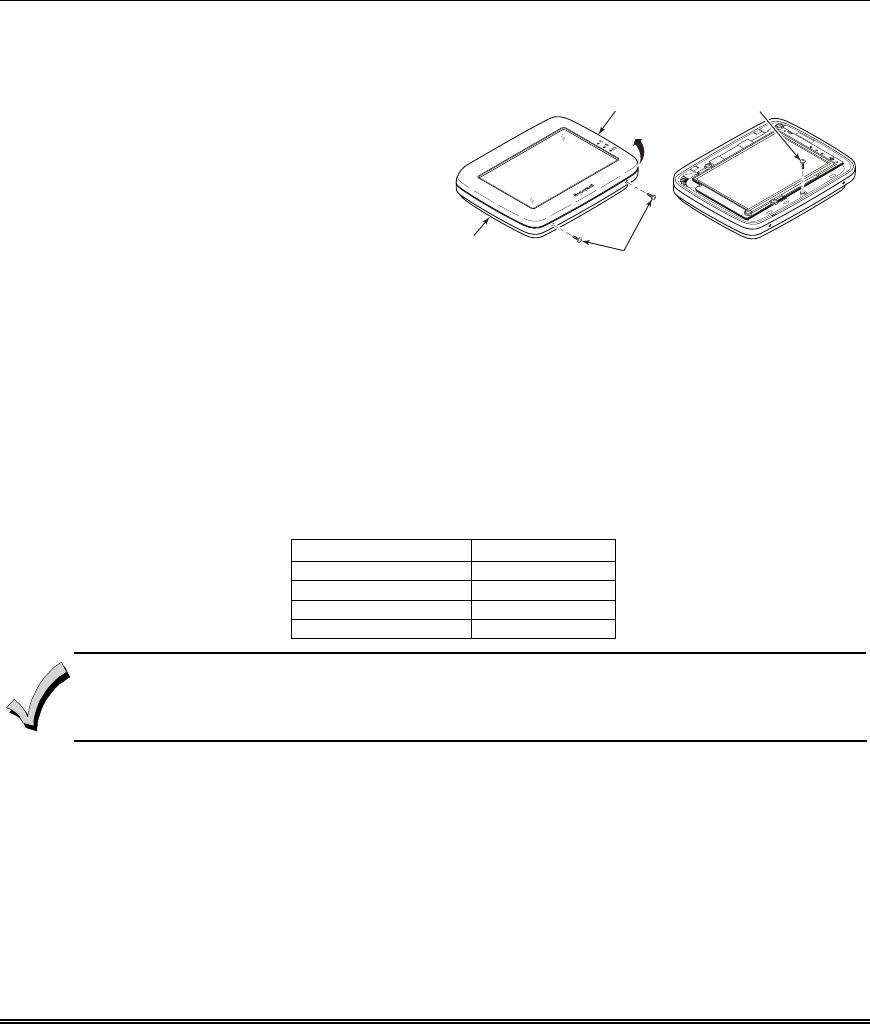
About the System (cont’d)
8
Mounting (European Installations)
using a center securing screw:
1. Detach case front by removing the two bottom
screws. Gently pull up using a screwdriver if
necessary and pry apart. Lift off cover.
2. Mount the keypad in its final location, (see
“Standard Mounting” or “Mounting without the
mounting plate”) install center securing screw
(supplied) and tighten to mounting surface.
3. Replace the case front and secure using the two
bottom screws.
6280-015-V0
INSTALL CENTER
SECURING SCREW
DETACH CASE FRONT
BY REMOVING SCREWS (2)
AND LIFT UP
CASE
FRONT
CASE
BACK
Wiring
Connect the Tuxedo Touch in parallel with keypads and other peripheral devices using the keypad
data (ECP) bus.
• If the Tuxedo Touch is used as the primary system keypad, maximum wire run length is 150 feet.
• If more than one keypad is wired to one run, then the maximum lengths must be divided by the
number of keypads on the run. (e.g., the maximum length is 75 feet if two keypads are wired on a
#22 gauge run).
Wire Gauge: Length
#22 gauge 150 feet
#20 gauge 240 feet
#18 gauge 350 feet
#16 gauge 550 feet
The Keypad draws up to 310mA. If you power the keypad from your panel’s Aux Power output,
check your panel’s Installation and Setup Guide and verify that this device and others do not
exceed your panel's Aux Power output capability. If it does, a supplementary power supply is
needed.
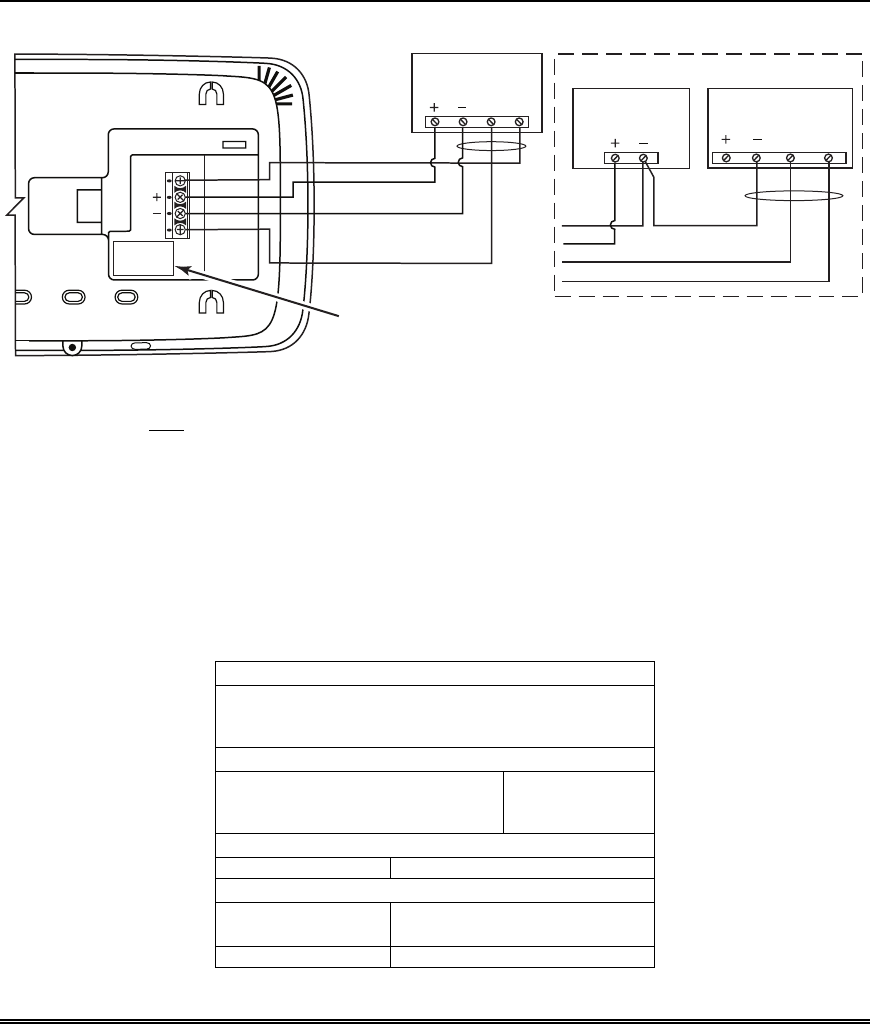
About the System (cont’d)
9
Connect the wires to the keypad terminal block as shown below.
BLACK
POWER FROM SUPPLEMENTARY
POWER SUPPLY IF USED
RED
BLACK
GREEN
YELLOW
CONTROL
TERMINAL STRIP
SUPPLEMENTARY
+12 VDC
POWER SUPPLY
P/N AD12612
BLACK (GND)
RED (+12VDC)
GREEN
(DATA TO
CONTROL)
YELLOW
(DATA FROM
CONTROL)
CONTROL
TERMINAL STRIP
AU X DATA
IN
DATA
OUT
AUX
DATA
IN
DATA
OUT
AUX AUX
Y
G
6280i-002-V0
RJ45
IP CONNECTION
IMPORTANT: When the keypad is powered from an auxiliary power supply, always apply power to
the control panel first and then the keypad. Failure to observe this sequence results in improper
operation of the keypad and may result in an ECP Error indication.
Installer Note: The Tuxedo Touch Screen has been calibrated at the factory. Ignore the “CALIBRATE”
button that appears on the “Options” screen after initial ECP setup. If the screen should require
recalibration, the end user may do so via the “Keypad Test” screen. See the “Diagnostic Tests” section
for instructions.
Supplementary external power supply must be Listed to UL 603 for UL installations, CAN/ULC-S318
for cUL installations, and capable of providing the required backup power.
Specifications
Mechanical Specifications:
Width: 8.23 inches (209.04mm)
Height: 5.59 inches (141.99mm)
Depth:1.13 inches (28.70mm)
Electrical Specifications:
Backlight OFF, Sound OFF 12V, 140mA
Backlight ON, Sound OFF 12V, 205mA
Backlight ON, Sound ON 12V, 310mA
Operating Environment:
Humidity 93% RH, non- condensing
Temperature:
Operating
14˚ F to 131˚ F / -10˚ C to 55˚ C
(UL tested 32˚-120˚F / 0 to 49˚C)
Shipping / Storage -40˚ F to 158˚ F / -40˚C to 70˚C
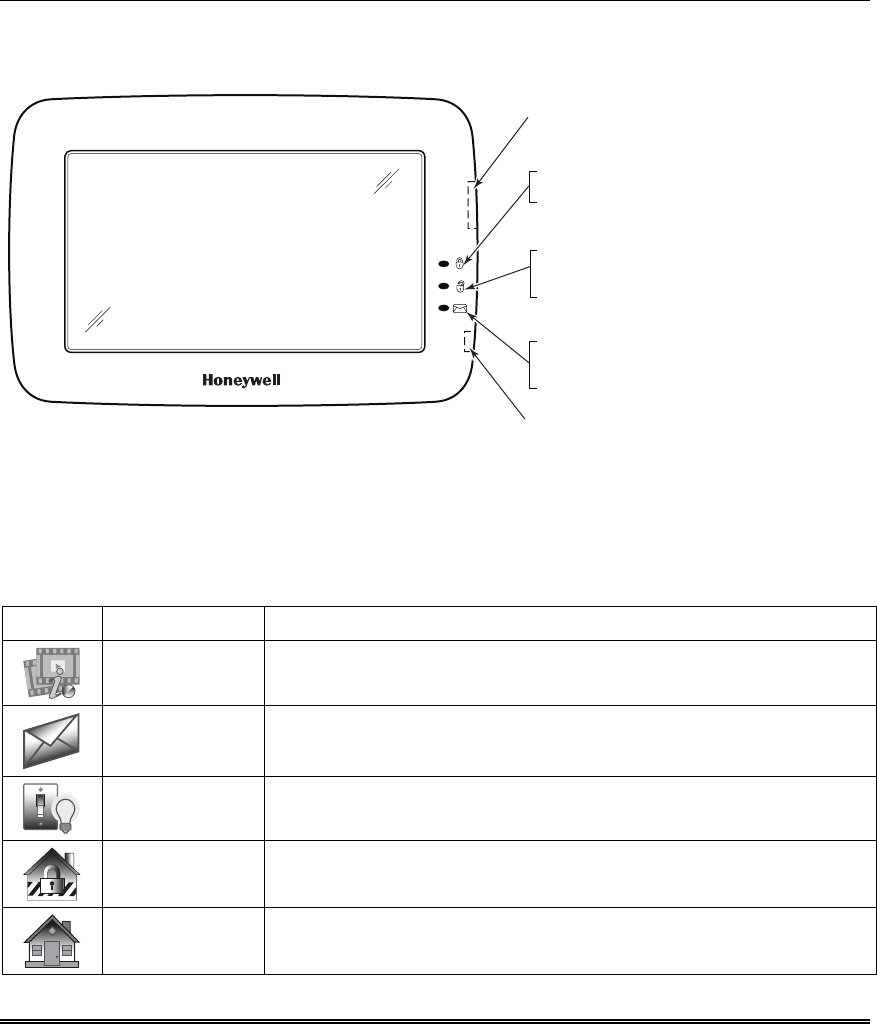
About the System (cont’d)
10
Front Panel LEDs
The Tuxedo Touch Keypad has three LEDs as follows:
6280-001-V0
FLASHING – The system contains new
message(s) for the User.
OFF – No new messages.
RESET BUTTON
Press to reset keypad
ON – System is armed.
OFF – System is not armed.
ARMED (RED) LED
READY (GREEN) LED
ON – System is disarmed and ready to arm.
OFF – System is armed or disarmed but not
ready. If disarmed, faults or troubles are present.
MESSAGE (YELLOW) LED
SD/SDHC CARD Slot
*Note: If the EN50131 Display feature is enabled, the "Armed" and "Ready" status LEDs turn OFF after 30
seconds and the screen returns to the Home screen until a valid user code is entered.
Navigation Icons
To aid in the navigation through the Tuxedo Touch WIFI screens, a set of user-friendly icons has been
provided. The appearance and function are described below.
ICON ICON TITLE FUNCTION
“Intro Video” Accesses the “Product Introduction Video”.
"Message" Record and retrieve Voice Messages.
"Automation" Accesses the Z-Wave setup, Scene setup, and Room setup screens.
"Security" Accesses the "Security" screen.
“Home” Returns you to the "Home" screen.
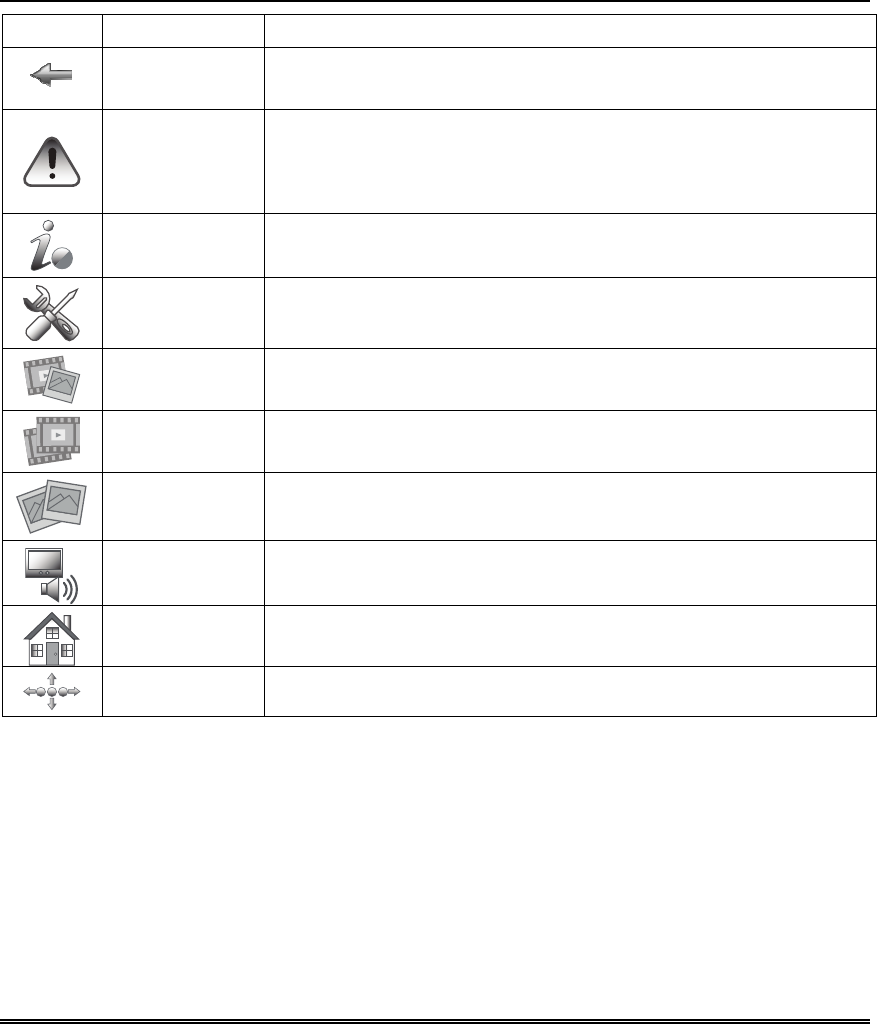
About the System (cont’d)
11
ICON ICON TITLE FUNCTION
“Back” Reverts to the last screen viewed.
“Panic”
Displays Emergency functions (as programmed by the installer). See
programming the Control Panel note.
Note: This icon is displayed and active on all screens except while in the Clean
Screen mode, during an LCD Display test in
Diagnostics
, and from the Video and
Camera screen.
“Control Panel
Message” This icon alerts the user to a Control Panel Message.
“Setup” Accesses the Setup menus.
“Multi-Media” Accesses the Message, Camera, Picture and Video feature.
“Video” Allows user to play video files.
“Picture” Allows user to display personal photos in a slide show format.
“Voice Status” Allows user to hear system status.
“Minimize Home” Minimizes the Home screen icons when viewing wallpaper displays.
“Maximize Home” Maximizes the Home screen icons when viewing wallpaper displays.
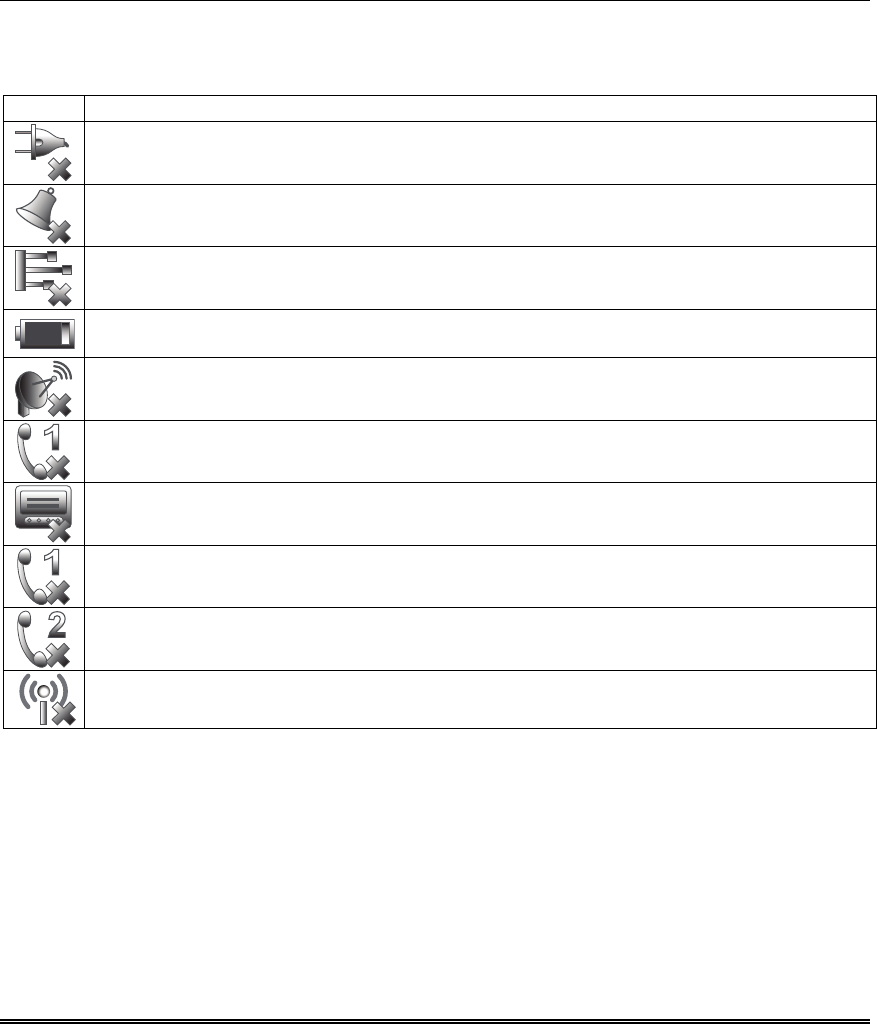
About the System (cont’d)
12
Panel Fault Displays
The “Security” screen displays an Icon(s) if a panel fault(s) occurs. The following Icons(s) may be shown
as applicable to you system:
ICON MEANING
AC Loss – The system is not receiving AC power.
Bell Failure – The system bell or siren has a problem.
Note: This Icon is displayed when interfacing with residential panels only.
Expander Failure – The system has a failure in an expansion module.
Low Battery – The system battery, that powers the system during an AC power loss, is low.
LRR Supervision Failure – The Communication Device used to communicate with the central
station has a supervision failure.
Max Attempts Exceeded – The system has exceeded the maximum attempts to communicate
with the Central Station.
Pager Failure – The system cannot communicate with an assigned pager.
Telco-1 Cut – The system is not able to communicate with the central monitoring station over the
primary phone line.
Telco-2 Cut – The system is not able to communicate with the central monitoring station over the
secondary phone line.
Wireless Failure – The system is not able to communicate with its wireless devices.
Note: If multiple faults exist, press the More Choices icon and then the Show Zones icon to view and
scroll through the complete list of faults.

13
Initial Setup
Programming the Control Panel
The keypad is not fully operational unless its address in the control panel has been enabled (set as an
alpha console) AUI type device, and assigned to a partition (where applicable). For a list of alarm systems
that the keypad can interface with, refer to the “Compatibility Table” in Section 1 of this document for the
quantity of keypads that may be used and the required control panel software revision level.
We recommend that you use either a standard alpha keypad or the keypad in Console Emulation Mode
when programming the control panel. When in the Console Mode, the keypad emulates an alpha keypad
and the programming of the panel is performed following the procedures provided in your panel’s
Installation and Setup Guide.
Note: When programming your control panel, if you change the zone types for your emergency zones you
may disable the emergency buttons in the keypad. The emergency buttons in the keypad are active for
zone types 06 (Silent Panic Button), and 07 (Panic Button), 08 (Medical Button), and 09 (Fire Button).
Additionally, the Medical button is also compatible with a zone type 15 (24-Hour Medical) for panels that
contain this zone type.
On residential control panels (VISTA-20P or equivalent):
Up to four keypads may be used (addresses 1, 2, 5 and 6). Addresses 1 and 2 (in field *189) are enabled by
default. If the defaults have been changed, enable these addresses (in field *189) using an alpha-keypad
and the Data Field Programming procedures located in the panel Installation and Setup Guide.
On commercial control panels (VISTA-128BP, VISTA-128FBP, or equivalent):
Addresses 1-2, and 3-30 may be used for controls under Rev. 10 supporting 3 AUI’s, see Important Note
below. Addresses 1-30 may be used for controls Rev. 10 and higher supporting 6 AUI’s. These addresses
in the control panel are normally not defaulted for AUI type devices. To enable the addresses you are
using for keypads, use an alpha-keypad and follow the procedures for “Device Programming” in your
control panel “Programming Guide.”
Important Note: If multiple keypads are being used, they must be set to addresses 1, 2, and X (where X
equals any address from 3 through 30). Only one AUI type device may be assigned to an address from 3
through 30 on commercial control panels.
The Keypad should not be assigned as a Master Console. If the keypad is assigned as a Master Console,
partitions must be controlled from the Partition screen or using the Console Emulation Mode.
Keypad Initialization
When initially powered, the screen displays the boot sequence and the "Set ECP Address" screen is
displayed.
If the system is incorporating only one keypad, leave the address set to 1 and press Apply. The boot-up
process continues until completion. If there are to be additional keypads in the system, after enabling
addresses in the control panel using an alpha-keypad, power-up each keypad one at a time, and set its
address to one of the addresses you enabled in the control panel.
Time and Date Setup
If not already set from the control panel, set the current time and date. Refer to Time/Date Setup.
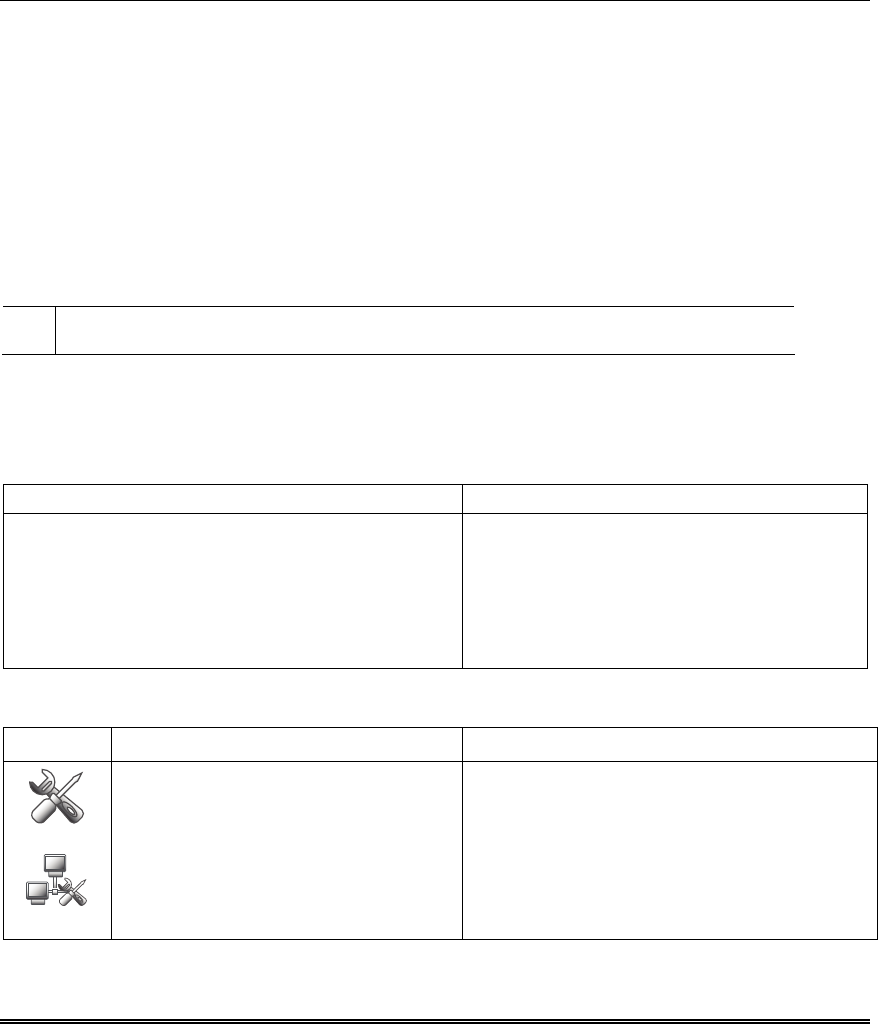
Initial Setup (cont’d)
14
Night Setup
The Keypad is defaulted to arm the system in the STAY INSTANT mode when arming the system
using the NIGHT icon. Select the arming mode to be activated when the NIGHT icon is pressed on the
“Arming” screen, refer to the “Night Setup” section.
IP Setup and Network Connections
To set up a wireless network, you need a broadband or high-speed Internet connection (not a dial-up
connection) provided by an Internet service provider (ISP).
Web Server/Hosting
The Tuxedo Touch keypad offers built-in web hosting capability to access your Security and Home
Automation System via any web enabled device. The Tuxedo Touch keypad IP Address is displayed on
the “IP Setup” screen as well as on the “Home” screen. This IP Address is used on a standard web
browser to control user functions.
IP Address Setup
In most cases, IP addresses are assigned ‘automatically’ (Automatic IP Address) by your Internet
Service Provider. If not, you may require a “Static” (Fixed) IP Address. Obtain that address by
contacting your Internet Service Provider.
To enable access to the Tuxedo Touch keypad options from any web enabled device, do the following:
ACTION NOTES
1. At your PC, Smart Phone or Tablet:
a) Navigate to the Settings feature.
b) Turn ON the “Wi-Fi” setting and select the
router to connect to. Enter a name and
password, if required.
c) Open the browser and enter the IP Address
displayed on the keypad into your browser.
After proper connection:
• Access to basic arming commands is available if
using a Smart Phone or Tablet browser.
• Full access to keypad options is available if using
a PC browser.
The IP Address is displayed in the lower left-hand
corner on the Tuxedo Touch Keypad “Home” screen.
Network Connections
To set up network connections, from the “Home” screen, and do the following:
ICON ACTION NOTES
1. At the Tuxedo Touch keypad:
a) Press the Setup icon.
b) Press the IP Setup icon.
2. Select a type of network connection:
LAN or WIFI and go to that section
below for further information.
A pop-up window displays the message:
Save the Change
Select Yes to save the settings.
UL • Web Server/Hosting is not Listed for use in UL installations.
• Remote Arming/Disarming/Programming is not to be used in UL Listed Installations.
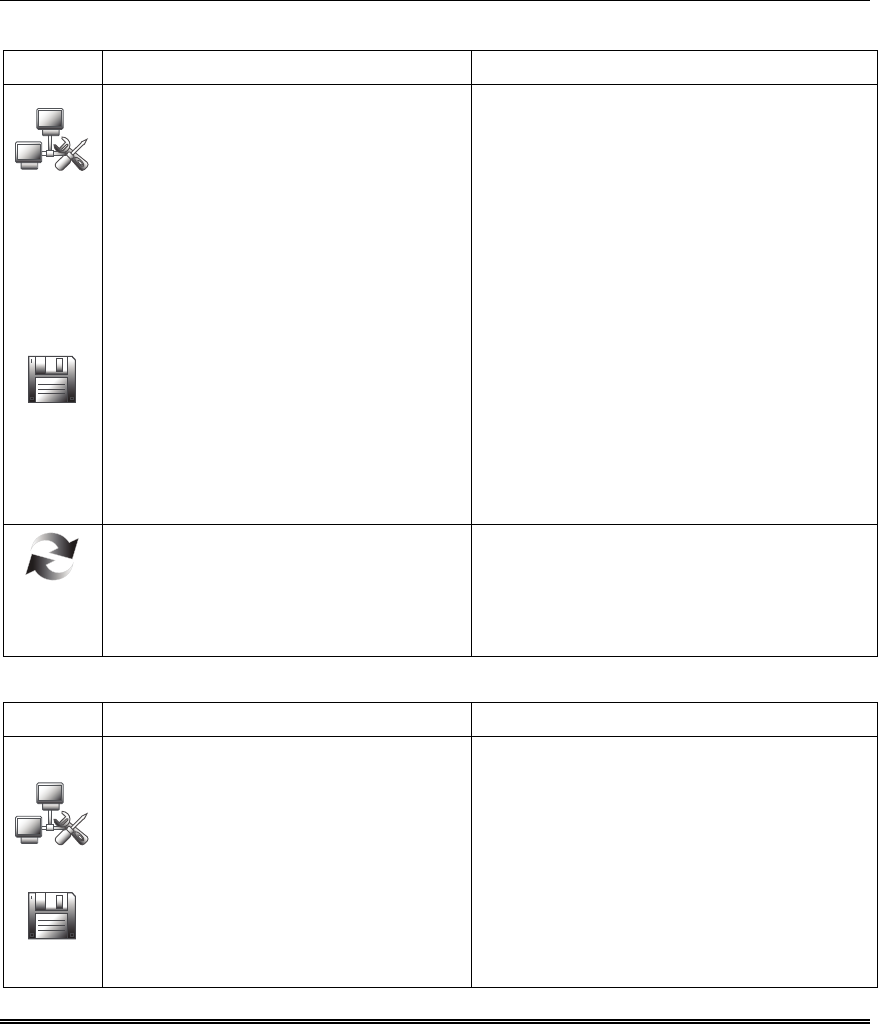
Initial Setup (cont’d)
15
Setup a LAN Connection
From the IP Setup screen, add a LAN network connection as follows:
ICON ACTION NOTES
1. At the Tuxedo Touch keypad:
a) Press the LAN ON button. Use the
Up/Down arrow to select the “Internet
Connection type”.
- Select “Obtain address automatically”
(to have the keypad begin to scan for
existing networks to connect to
automatically).
- Select Static IP to enter a “Fixed IP
address” by pressing the first set of 3
zeros (“000”) on the screen, and enter
the first three numbers of the address
on the “Data Entry Keyboard”. Repeat
this step until the complete address has
been entered and press Apply.
3. Highlight the remaining fields and
enter the required information for IP
Address, Subnet Mask, Default
Gateway, and DNS Server.
4. Press the Save icon.
A pop-up window displays:
This will switch off WLAN Network, do you want to
continue? Yes or NO
Use the Data Entry Keyboard to enter the required
information.
• Press the “up arrow” to switch to capital letters.
• Press the Space key to add a space between
characters.
• Press the x key to delete/backspace.
• Press the ABC/123 key to switch between
numerals and symbols/characters.
• Press GO to return to Account Setup.
A pop-up window displays:
Network Details Saved
5. Press the Refresh icon; the IP
information will automatically update.
This may take up to 60 seconds.
6. At your PC, Smart Phone or Tablet
browser, start your browser and enter
your IP Address.
After proper setup, the IP Address is displayed on the
“Home” page.
Setup a WLAN (Wi-Fi) Connection
From the IP Setup screen, add a WLAN network connection as follows:
ICON ACTION NOTES
1. At the Tuxedo Touch keypad:
a) Press the WIFI ON button.
- Highlight the field from the list of
Wifi Networks to connect to.
- Or select Add Network.
b) Highlight each field and enter the
required information for SSID, Security
Mode, Passphrase/Shared Key.
c) Press the Save icon.
2. Press the Refresh icon; the information
will automatically update. This may take
A pop-up window displays:
This will switch off LAN Network, do you want to
continue? Yes or No
Use the Data Entry Keyboard to enter the required
information.
• Press the “up arrow” key to switch to capital letters.
• Press the Space key to add a space between
characters.
• Press the x key to delete/backspace.
• Press the ABC/.?123 key to switch between
numerals and symbols/characters.
• Press the “#+=” key to switch to symbols.
• Press GO to return to Account Setup.
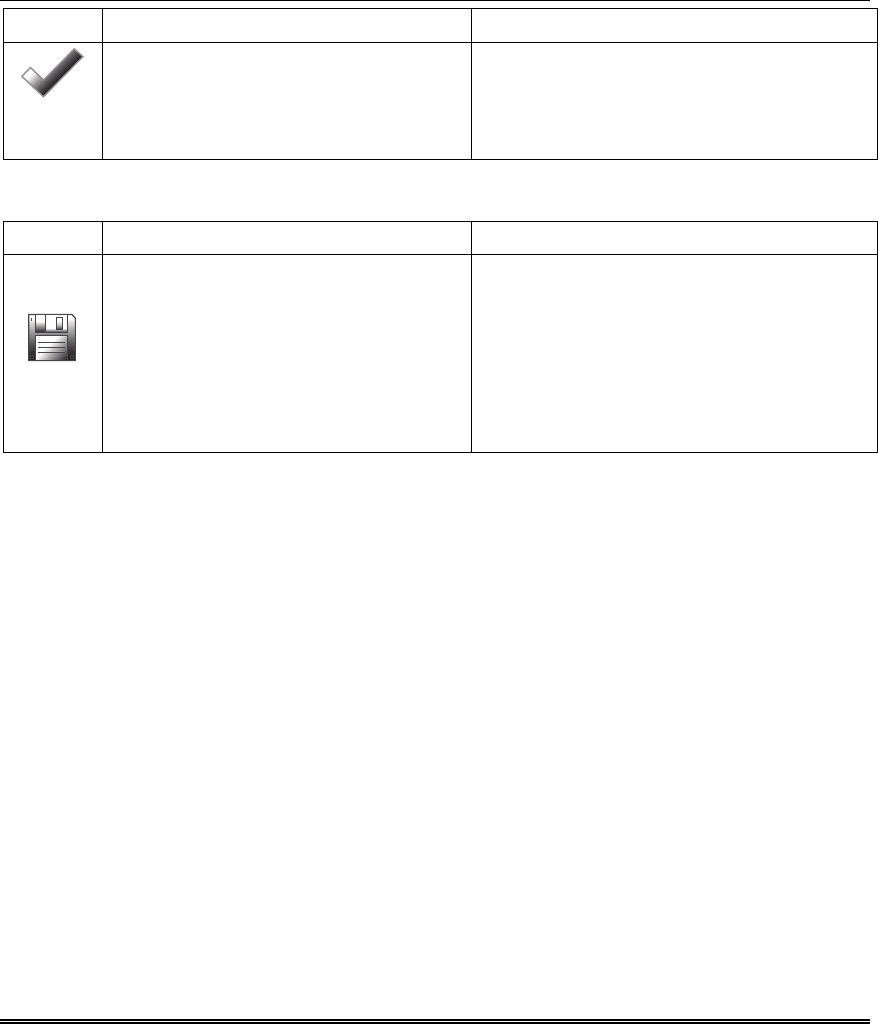
Initial Setup (cont’d)
16
ICON ACTION NOTES
up to 60 seconds.
3. At your PC, Smart Phone or Tablet
browser, start your browser and enter
your IP Address.
A pop-up window displays:
Network Details Saved
A pop-up window displays the message:
Settings saved.
Select OK to save.
Account Setup
Account Setup allows you to a set up an Account for up to 5 users. Create a user account as follows:
ICON ACTION NOTES
1. Press the Account Setup button.
2. Highlight the User Name/Password
fields on the list and enter the data for
each on the “Data Entry Keyboard”;
press GO.
3. Press the Save icon. The new user is
displayed on the screen.
4. Press the Clear button to clear the User
information.
A Confirmation window displays the message:
Settings saved.
The ENABLED button is displayed when a successful
network connection is completed.
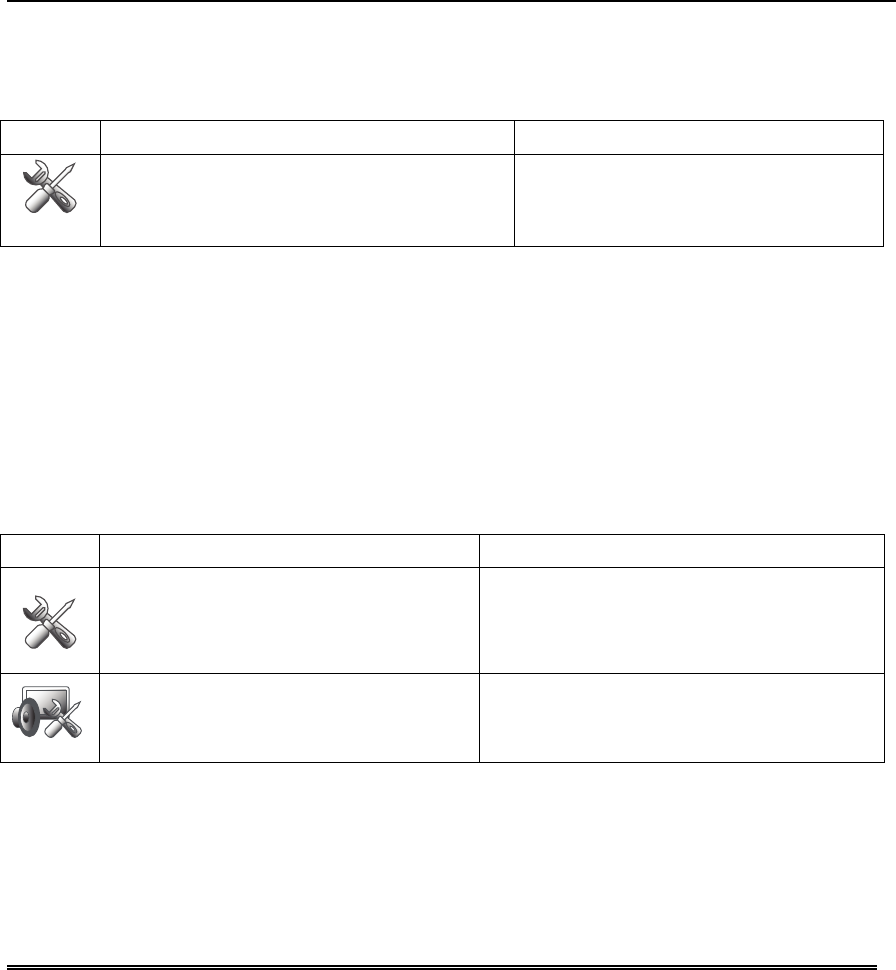
17
Setup
You may access Brightness and Volume, Display & Audio Setup, System Setup and IP Setup
from the "Setup" screen.
Brightness and Volume Control
From the "Home" screen, access the "Setup" screen as follows:
ICON ACTION NOTES
1. From the Home screen, press the Setup icon.
2. Move the Brightness/Volume slide bar up or
down to increase/decrease brightness/ volume.
Yes saves the change. No discards the change.
If changes are made, when you exit a “Settings
Changed!” pop-up window is displayed asking
“Remember New Settings?“
Display & Audio Setup
You may access Operating Modes, Backlight Off After Time, To Homepage After Time, Auto
Slideshow After Time, and Clean Screen from Display & Audio Setup.
Operating Modes
Operating modes provides access to Chime Mode, Voice Mode, and Voice Chime.
• Chime Mode – Keypad chimes whenever a door or window is open.
• Voice Mode – Keypad voice annunciates whenever a change in system status occurs such as Armed,
Disarmed, or Alarms.
• Voice Chime – The chime mode and voice mode are in effect. The chime beeps followed by voice
annunciation.
From the Home screen, press the “Setup” icon, and do the following:
ICON ACTION NOTES
1. Press the Disp & Audio Setup icon.
2. Enter your Authorized Code, if
required.
If the Chime Mode and Voice Mode are both selected,
the Voice Chime is automatically selected.
When the keypad exits the “Operating Modes” screen,
your selection is saved.
3. Select Chime Mode or Voice Mode to
turn the mode on or off.
4. Press the HOME or BACK icon after
making your selection.
It may take a few seconds for the Chime Mode to take
effect.
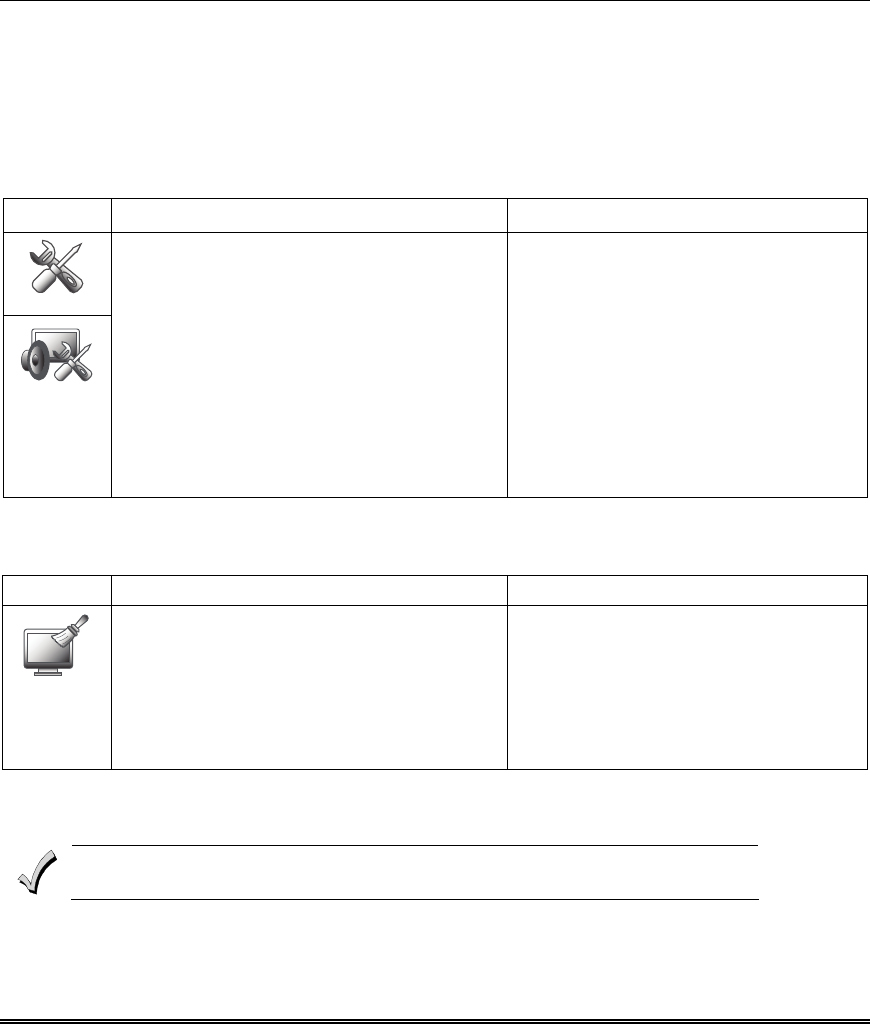
Setup (cont’d)
18
Adjust the Screen Timeouts
When the keypad is left idle, it automatically:
• Turns the “Backlight Off After” the selected backlight off time has expired (unless “Never” option is
selected).
• returns to the “Home” screen after the selected “To Homepage After” time has expired (unless
“Never” option is selected), and
• if enabled, the “Auto Slideshow After Time” begins the slide show.
To select the desired screen timeouts, do the following:
ICON ACTION NOTES
1. From the "Home" screen, press the Setup
icon.
2. Press the Disp & Audio Setup icon.
3. Enter your Authorized Code.
4. Press the button next to the screen
timeout setting to be changed and press
the up/down arrows and select the time
period for each option.
5. Press the Save icon to save the settings.
If changes are made, a “Display Settings
Changed!” pop-up window is displayed asking “Do
you want to save them?“
Settings include:
• Backlight Off After X time
• Return To Homepage After X time
• Auto Slideshow After X time.
Notes
• The “To Homepage After” Time option is only
available if the EN50131 display option is not
enabled by the installer.
• When in EN50131 mode, “Auto Slideshow
After” is preset to “1” minute and can not be
changed.
Clean Screen
With the exception of normal cleaning, the keypad is maintenance free.
Press the “Display and Audio” icon, and do the following:
ICON ACTION NOTES
1. Press the CLEAN SCREEN icon. A pop-up
window displays "Touch Screen has been
disabled so that you may wipe the screen clean.
Please use a damp, soft cloth. DO NOT use any
liquids, sprays, or ammonia-based cleansers.
Press CONTINUE to disable touchscreen."
*Panics cannot be initiated during this process*
2. Press Continue or Cancel to exit.
When the "Continue" icon is pressed the
message "Touch Screen Disabled for =30
Seconds" is displayed. During these 30
seconds the touch screen should be wiped
clean of fingerprints using a mild soap solution
and a soft cloth. When the counter reaches
zero, the window automatically closes and the
touch screen is active.
IMPORTANT: Do not use an abrasive cleaning agent or abrasive cloth when cleaning the keypad or
damage to the touch screen may occur.
The Emergency screen cannot be accessed while running in the clean screen mode.
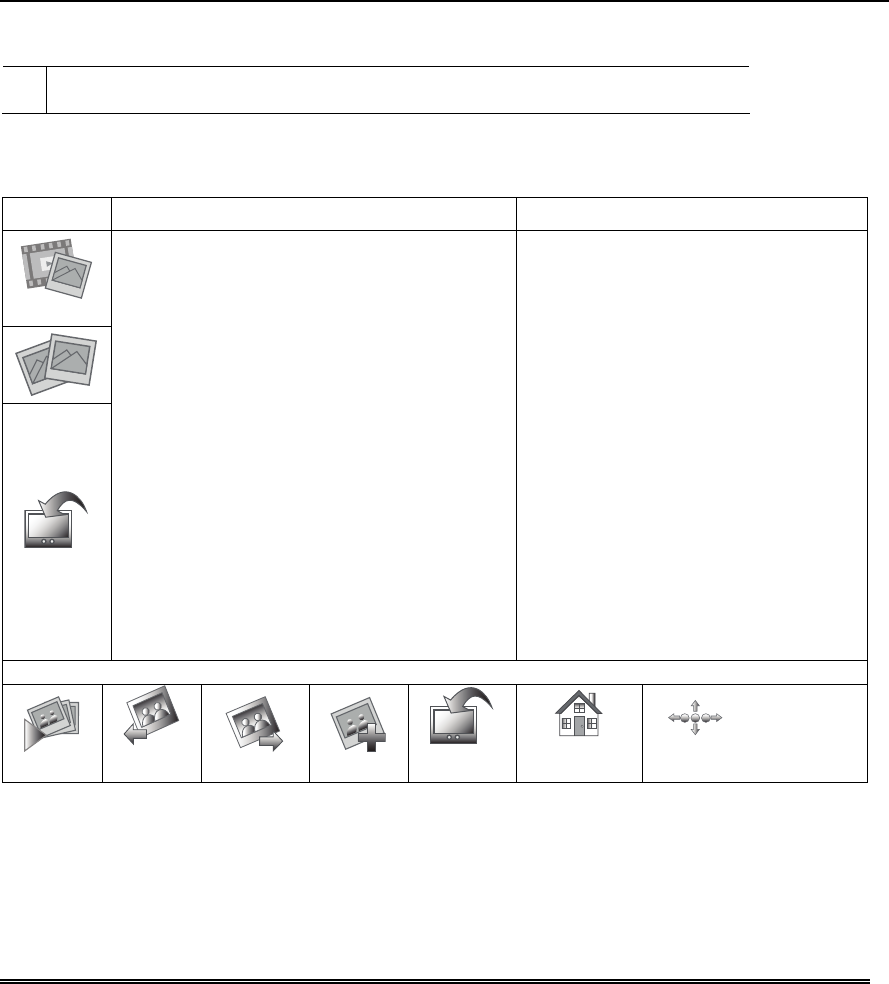
19
Multi-Media
This feature allows you to access voice messages, play video files, display personal photos in a slide
show format, and view up-to four cameras at one time from your keypad.
UL Multi-Media functionality is supplementary only and has not been evaluated by UL.
Picture Setup
The Picture feature allows the user to display up to 1000 personal photos on the touch-screen and can
be accessed from the Home screen by pressing the Picture icon, or access this feature as follows:
ICON ACTION NOTES
1. Insert your personal media (SD/SDHC)
card (with stored picture files) first.
2. Press the Multi-Media icon and then press
the Picture icon.
3. Select the type of viewing transition
desired (Standard, Horizontal, Vertical or
Fade Out) by pressing the Transition arrow.
4. Press the Slide Delay arrow to select the
time interval that you want to allow between
each photo being viewed. Choose from (5, 10,
15, or 20 seconds).
To set a picture as wallpaper:
1. Use the slide bar to highlight the file you
want to be displayed on the keypad screen.
2. Press the Set Wallpaper icon; view your
selection from the “Home” screen.
Photo files can be viewed from the
(SD/SDHC) Card. Formats supported are
.bmp, png or .jpg files.
NOTE:
• To exit slide show at any time and resume
keypad operation, press anywhere on the
screen.
• The first image is displayed and a list of
stored images appears on the screen.
• When an image is loading, no other
Picture Setup function can be performed
(play, previous, next, add or set
wallpaper).
Press the TOP button to move up one level in
the directory.
Press the OPEN button to view larger images
and/or open directories, select from the list of
stored images.
Press the CLEAR ALL button to clear all
pictures from the current slide show rotation.
NOTE: When viewing wallpaper displays, the
Home screen icons can be minimized by
touching the “Minimize Home” icon.
Picture Icons
Play Image
Previous
Image
Next Image
Add Image
Set
Wallpaper
Minimize
Home
Maximize Home
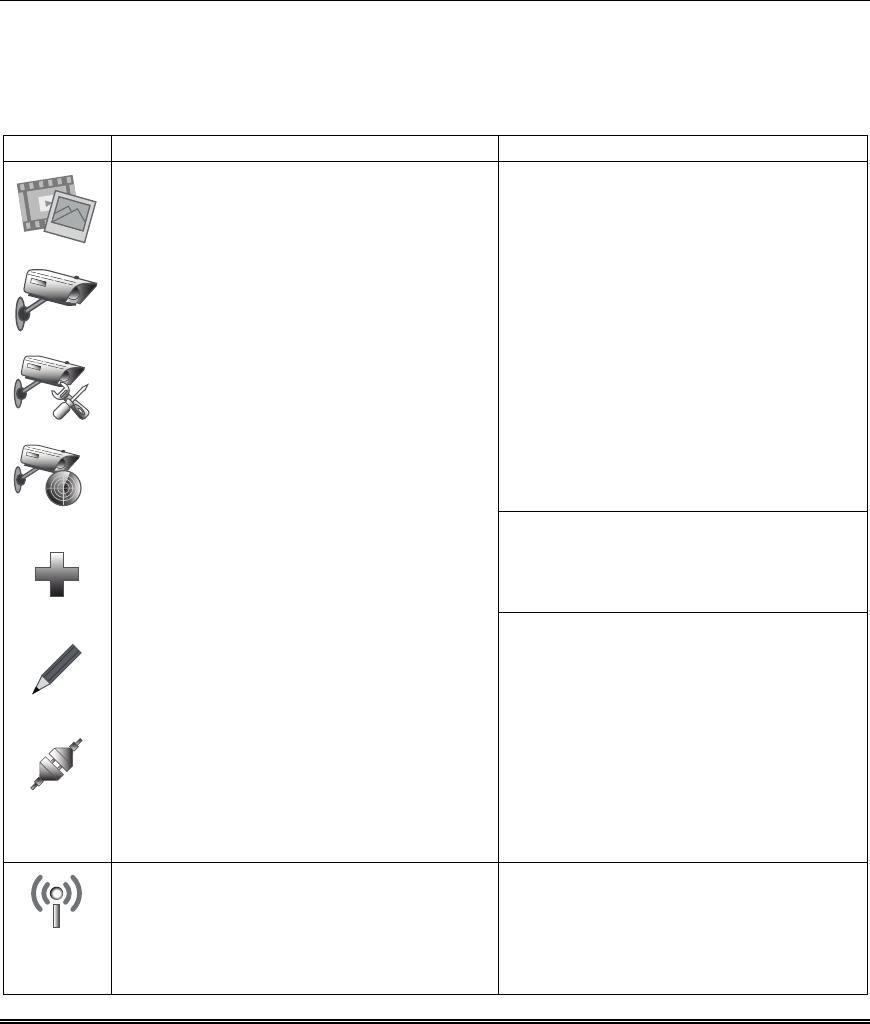
Multi-Media (cont’d)
20
Camera Setup
The Camera feature allows you to view up-to four cameras at one time. Cameras should be in their
final location and turned on before they are added to the system.
IMPORTANT: Use the web browser to view cameras for non-security purposes only. Camera streams viewed from the
web browser can stop without indication due to network connection issues.
To add a camera, do the following:
ICON ACTION NOTES
Initial camera setup cannot be performed over
a wireless connection.
Notes:
1. QuickTime® media player must be installed
on your PC.
2. Max. suggested camera resolution = 640 x 480.
Max. suggested frame rate = 5 fps.
3. Camera viewing is not compatible if using
Opera web browser.
Use the Data Entry Keyboard to enter all
required information.
• Press the Up Arrow key to switch to capital
letters
• Press the X key to delete
• Press the ABC/.?123 key to switch between
numerals and symbols/characters.
• Press GO to return to the “Add New Camera”
screen.
Enter the appropriate information (NAME, IP
ADDR, RTSP, MJPEG, MOBILE, RTSP PORT#
MODEL, USER NAME, PASSWORD,
RESOLUTION, FRAME RATE, and HTTP
PORT#, if known.
1. Connect a Cat5/6 cable to the back of the
Tuxedo Touch Keypad and connect the
opposite end to your Ethernet on your
existing “powered-up” router.
2. Connect a Cat5/6 cable to the back of your
camera (LAN) and connect the opposite end
to the Ethernet on your router.
3. Apply power to the Camera. Wait a few
seconds for initial power-up of camera.
4. Press the Multi-Media and Camera icons
(or press the Camera icon from the “Home”
screen) and then press the Camera Setup
icon. The “Camera List” screen is displayed.
5. Press the Discover icon to locate the
camera. Once located, highlight the camera
name, press the Edit icon and go to Step 7.
6. If the camera information is not
automatically obtained, press the Add icon
to manually enter information on the “Add
New Camera” screen.
7. To edit camera information, highlight
the camera name and press the Edit icon;
the “Edit Camera Settings” screen is
displayed.
a) To retrieve camera settings and connect
to the camera, press the Camera
Settings icon, or
b) Highlight each field to enter new
information on the “Data Entry
Keyboard” and use the up/down arrows
to change settings.
c) Press Save or Reset.
A pop-up window displays:
“For remote camera viewing service, please
contact your alarm company and ask for
Total ConnectTM service and provide this
camera’s MAC ID ‹00c0027fcd15›. Press
continue to prepare the camera for Total
Connect service.” Press CONTINUE or
CANCEL.
Press the Reset icon; the Pop-up window
displays “Do you want to reset the camera?”
Select Yes or No.
8. When all cameras have been added, press
the Camera WIFI icon and enter the camera
wireless settings information from your
router.
NOTE: Camera WIFI setup is applicable only for
discovered cameras.
Enter the appropriate wireless information.
SSID: ANY
Security Mode: Disabled, WPA personal, WPA2
personal, or WEP.
Network Type: Infrastructure…
Domain: USA…
Channel: Auto
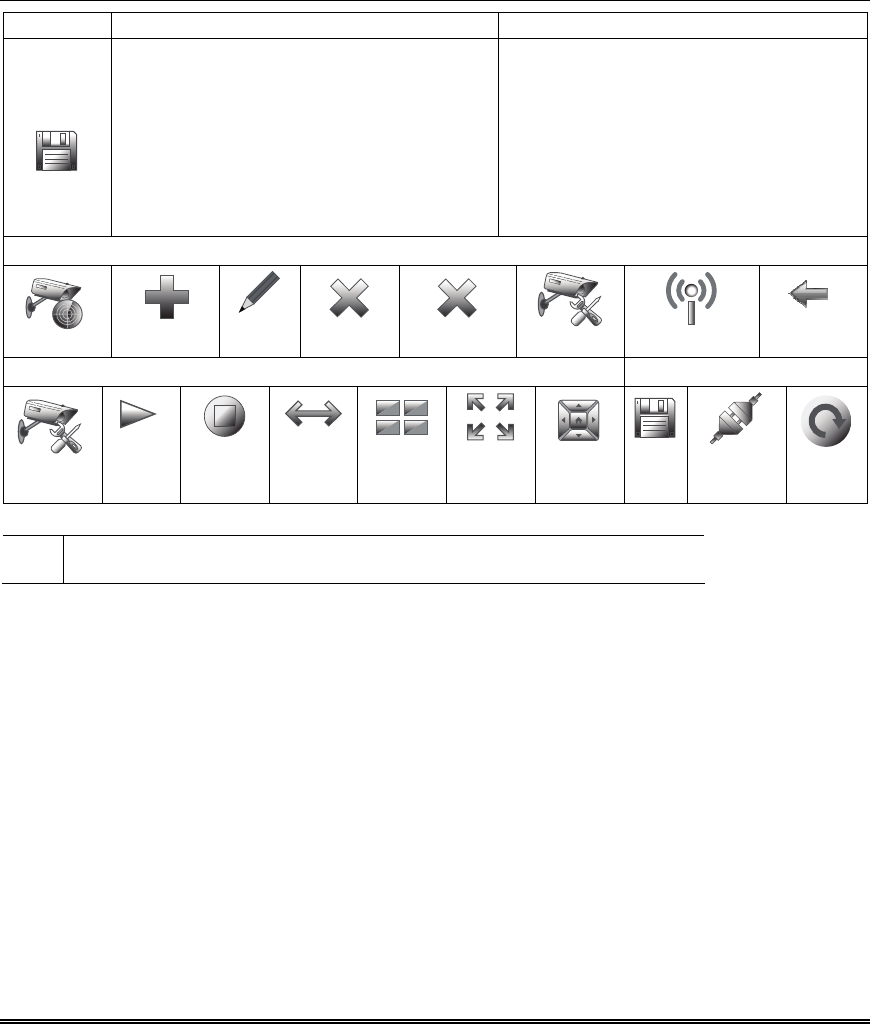
Multi-Media (cont’d)
21
ICON ACTION NOTES
9. Press Apply to All to set cameras for
wireless operation. If the camera does not
have wireless capability, leave the camera
connected to router.
10. Press the Save or Reset icon.
11. After power has been recycled to the
camera, remove the Cat5/6 cable from the
wireless cameras to view wirelessly via the
Tuxedo Touch Keypad.
For Security Mode information enter:
TxKey: 1, 2, or 3.
WEP Encryption: 64 bit Key (10 Hex Chars) or
128 bit Key (26 Hex Chars).
Authentication: Open System or Shared Key.
Passphrase: then press GENERATE.
Key: must consist of 10 hexadecimal characters.
Camera Setup Icons
DISCOVER
ADD
EDIT
DELETE
DELETE ALL
SETTINGS
CAMERA WIFI
BACK
Camera Icons Add/ Edit Icons
CAMERA
SETUP
PLAY
STOP
AUTO
PAN
QUAD
VIEW
FULL
VIEW
PAN/TILT SAVE
CAMERA
SETTINGS
RESET
Note: To use the Pan/Tilt feature in Quad View, select the camera name from the camera list and then press Pan/Tilt.
UL Camera functionality is supplementary only and has not been evaluated by UL.
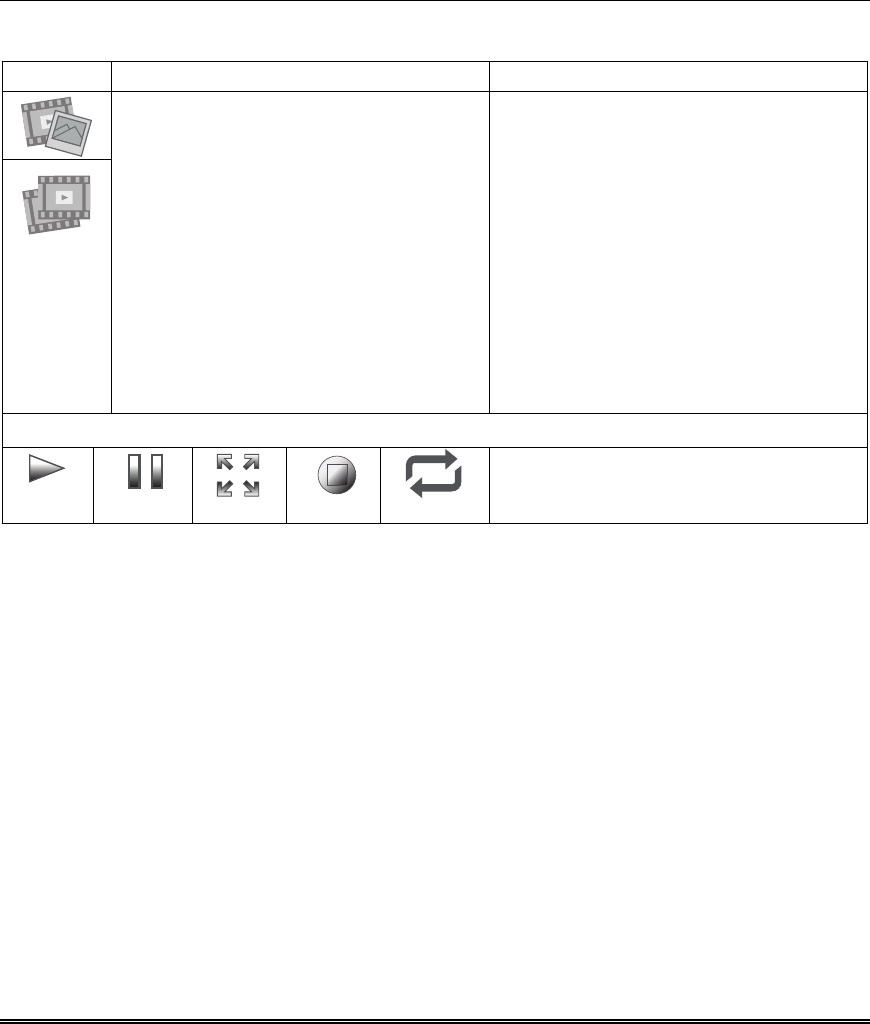
Multi-Media (cont’d)
22
Video (Audio) Setup
To access the Video (Audio) feature, from the “Home” screen do the following:
ICON ACTION NOTES
1. Insert your personal media
(SD/SDHC) card (with stored video files).
2. Press Multi-Media and then press the
Video icon.
3. Highlight a video file from the list and
press Play to start the selected video file.
4. Press the Repeat icon to continually
replay the selected video.
5. Deselect the Repeat icon to
automatically play the complete list of
video files starting with the first video
and ending with the last.
A Video Converter is required to convert videos
for proper playback on the Tuxedo Touch Keypad.
Use an Internet search engine to locate and
download a Video Converter, then follow the
steps in the Video Converter Instructions
(provided in the carton).
Notes:
• Maximum video resolution should not exceed
400 x 240.
• If the video file causes the keypad to lock, use a
small object (such as a paper clip) to press the
reset button located in the lower right-hand side
of the keypad to reset the keypad.
• Videos can not be played when the EN50131
Display is turned ON.
• To exit Full View mode at any time while a
video is playing, press anywhere on the screen.
Video Icons
Play
Pause
Full View
Stop
Repeat
Use the slide bar to scroll through the video list.
Press the appropriate icon to Play, Pause, view a
Full View, Stop or Repeat the video.

23
System Setup
From System Setup, you may access CS Setup, User Setup, Time & Date, and Advanced Setup.
CS Setup
You may access ECP Address, CS Options/Operating Modes, Screen Security, Device Events, Code Authority
and Panel Configuration from the CS Setup screen.
From the “Home” screen, press the Setup and System Setup icon and perform the following:
ICON ACTION NOTES
1. From the System Setup screen, press
the CS Setup icon.
2. Enter your Authorized Code, if required.
3. Press the ECP Address icon.
If the top of the screen is displaying “ECP Error”,
the ECP address in the keypad is not valid for
the panel that it is connected to. In this case,
change the ECP to the keypad default code of
“4140” to advance to the next screen.
Note: Default code “4140” is the Tuxedo Touch
default installer code before connecting to a
control panel. Once connected to a control
panel, use that panel’s installer code.
ECP Address Selection
After enabling addresses in the control panel using an alpha-keypad, power-up each keypad one at a
time, and set its address to one of the addresses you enabled in the control panel. Otherwise, access
the Central Station screen then follow this procedure to change the address on the unit.
To change the address, perform the following:
ICON ACTION NOTES
1
2
3
1. Press the ECP Address icon.
2. Select the ECP address for this keypad
using the Up/Dn arrows.
3. The available ECP addresses are:
1-2, 5-6 for residential controls
1-2, 3-30 for commercial controls under
Rev. 10 supports 3 AUIs. See
Important Note below.
1-30 for commercial controls Rev. 10
and higher supports 6 AUIs.
IMPORTANT: If multiple keypads are being used,
they must be set to addresses 1, 2, and X (where X
equals any address from 3 through 30). Only one
AUI type device may be assigned to an address
from 3 through 30 on commercial control panels.
When the keypad cannot communicate with the
alarm panel, the message “ECP Error” is
displayed, check the following:
• Verify that the AUI type device is enabled in
the control panel, and that the ECP address in
the keypad matches the address enabled in the
control panel. Use a different address for each
device.
• If powering the keypad from a power supply,
make sure you have a common ground
installed (wiring between Power Supply "gnd"
and panel "Aux. power neg").
NOTE: When the ECP address is changed, and
Apply is selected, the keypad resets.
The keypad should not be assigned as a Master
Console. If the keypad is assigned as a Master
Console, partitions must be controlled from the
Partition screen or using the Console Emulation
Mode.
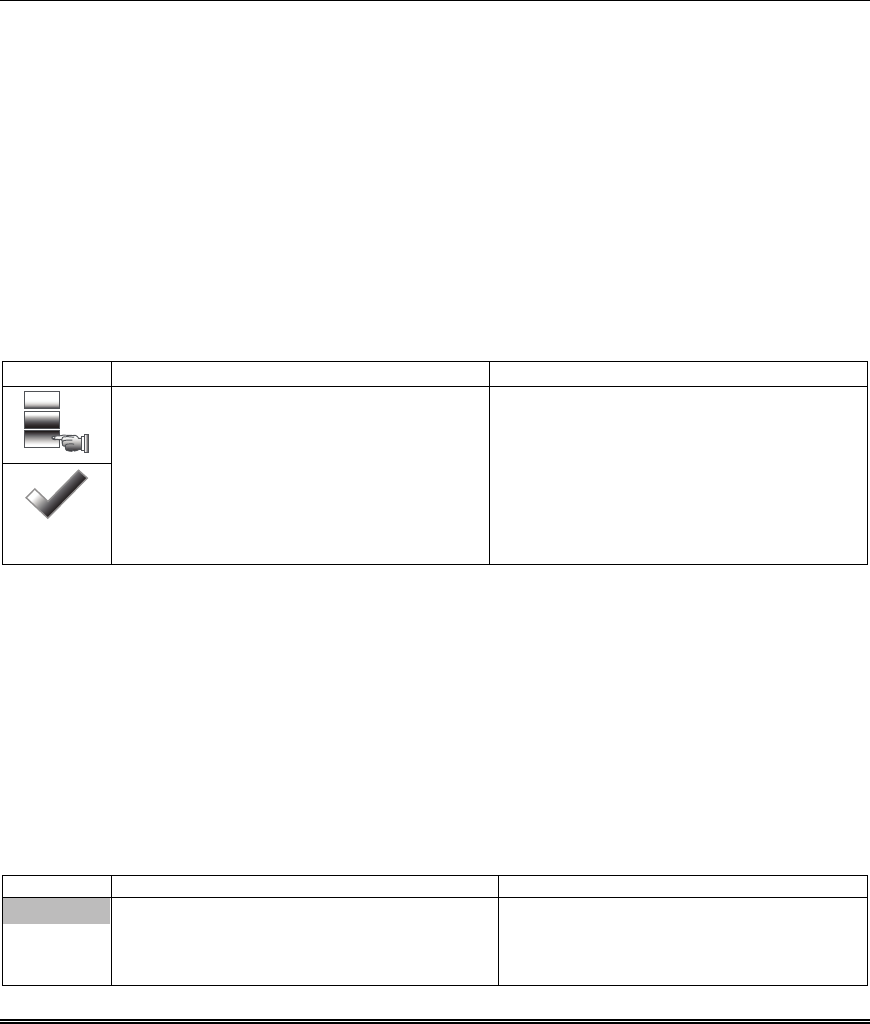
System Setup (cont’d)
24
CS Options / Operating Modes
The "CS Options" menu allows you to enable Display Lighting and the EN50131 Display feature.
The "Operating Modes" menu allows you to access "Normal Mode", "Safe Mode" and
"Automation/Demo Mode".
Compliance Feature (EN50131)
The EN50131 Display compliance feature is a European Standard designed to prevent unauthorized
users from knowing the status of the Security System. When the EN50131 Display is turned ON:
• The keypad returns to the "Home" screen after 30 seconds; "Armed" and "Ready" LEDs turn OFF.
• The "To Homepage After" time setting changes to 30 seconds and the time is non-selectable.
• The “Auto Slideshow After” is preset to “1” minute and can not be changed.
• The Security, Message and Lighting screen does not display system status until an authorized
user code is entered.
• The "Setup" menu does not display system status until an authorized user code is entered.
• Videos can not be played.
From the Home screen, press the Setup and System Setup icon.
Operating Modes
Safe Mode
The Safe Mode may be automatically entered by the program on a communication failure or may be
entered manually on command.
Automatic Entry
In the rare event that the keypad cannot successfully communicate in its graphic mode with the control
panel, the screen presents you with a message of “Problems detected. Start Keypad in Safe Mode?” and
requests a “Yes” or “No” response. If you answer with “Yes”, the keypad goes into the Safe Mode. If you
answer with “No”, the keypad tries to communicate with the panel again. After 3 consecutive times of
receiving no response, the keypad enters the Safe Mode automatically.
Manual Entry
Note: ONLY enter the Safe Mode from the Normal Mode. Entering the Safe Mode from the
Automation/Demo Mode may result in incorrect display of the Emergency Function keys.
ICON ACTION NOTES
! SAFE MODE !
1. Select Safe Mode and then press Apply.
2. Press OK.
3. To exit, touch the safe mode bar and
touch Yes to return to Normal Mode.
The “Warning” message "Keypad will reset to
activate changes" is displayed.
The keypad resets and restarts in the Safe
Mode.
ICON ACTION NOTES
1. Press the CS Options icon.
2. Enter your Authorized Code, if
required.
3. Select “Lighting" or "EN50131 Display"
to turn the option on or off.
4. Select "Normal Mode" or "Safe Mode" to
turn the option on or off.
Apply accepts all changes.
Note: The Automation/Demo Mode option
allows the automation and multi-media features to
operate in a non-security mode. When this option
is selected, the keypad does not communicate
with the control panel and any user can select
Advanced Setup screens.
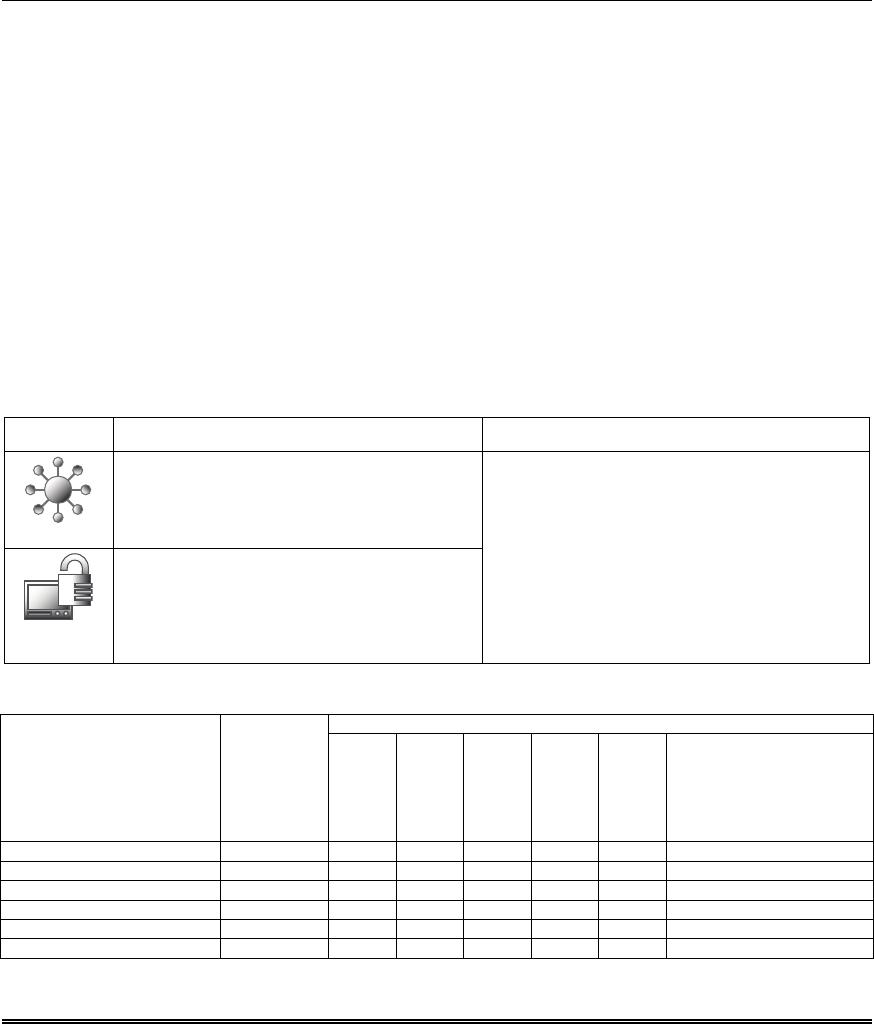
System setup (cont’d)
25
Operating in the Safe Mode
While in the Safe Mode, the Home screen displays the Security Icon, Panic Icon, and Message Icon. A
message at the lower left side of the screen is displaying: !SAFE MODE!
This is a limited mode of operation. While in this mode:
• You can use the Security icon to access the Console Emulation Mode of operation to try to clear your
faults, disarm the system, or enter additional Alpha Keypad commands specified in your panel User
and Installation Guides. You can perform almost all functions that you can perform from a standard
non-graphic alpha keypad.
• You can press the “Panic” icon and generate Emergency Messages as defined in the panel's home
partition for this keypad.
• The Armed and Ready LEDs on the front of the keypad indicates the keypad’s home partition status.
• The Chime mode functions in the Safe Mode: however, you do not have Voice, Voice Chime, or
Message capability.
Note: Z-Wave Scenes do not function in Safe Mode.
WARNING: The Slide Show feature does not start automatically in Safe Mode.
Screen Security
The Screen Security icon displays a list of authority levels and the user level that has been given
access to them. To view and/or edit Screen Security, do the following:
ICON ACTION NOTES
1. From the System Setup screen, press
the CS Setup icon.
2. Enter your Authorized Code.
3. Press the Screen Security icon.
4. If authority levels are correct, press
BACK or Home to exit the menu.
5. If changes are necessary, select the
line to be changed and the level of user to
have access; then select OK or Cancel.
Note: The Screen Security screen contains a
heading of Advanced Setup, Central Station Setup,
Disp. & Audio Setup, Event Logs, Lighting,
Message, Security, or Time/Date highlighting the
line was selected for change.
The Screen Security screen is re-displayed listing
any changes.
Note: The User Levels listed on this screen match
the User Levels in commercial panels. See the
following chart for corresponding User Levels in
Residential Panels.
Residential Panels and Screen Security
Access Level Chosen in Keypad Screen Security
Authority Level in Panel
Matching
Authority
Level in
Keypad
Installer
Master
Manager
Operator A
Operator B
Operator C
System Master Master No Yes Yes Yes Yes Yes
Partition Master Master No Yes Yes Yes Yes Yes
Standard User Normal No No No Yes Yes Yes
Arm Only N/A No No No No No No
Guest Guest No No No No Yes Yes
Duress N/A No No No No No No
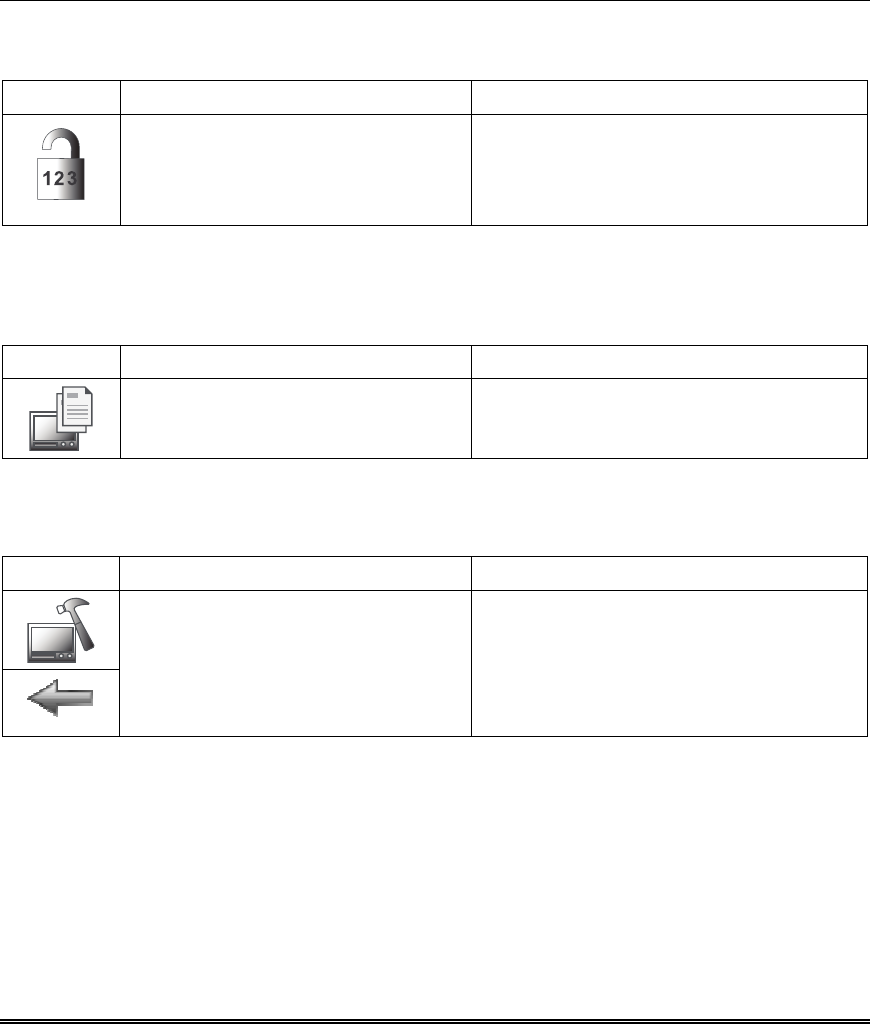
System Setup (cont’d)
26
Code Authority
The Code Authority screen displays User Names and Partition Authority Level for the User Code. To
view the Code Authority level, do the following:
ICON ACTION NOTES
1. Press the Code Authority icon.
2. Enter the 4-digit User Code for the
user that you want to obtain Authority
Level information about.
3. Press BACK.
Note: If the User Code entered is not active in the
system, a “NOT VALID” message will be displayed.
Device Events
Your system has the ability to record events in a history log. Each event is recorded with the time and
date of its occurrence. The control panel must be programmed to record various system events in
installer programming mode. To view the Device Events, perform the following:
ICON ACTION NOTES
1. Press the Device Events icon. A list
of events is displayed.
To view a record of events in a history log, press the
up/down arrow to scroll.
Panel Configuration
The Panel Configuration screen displays the configuration of the panel. To view the panel
configuration, do the following:
SCREEN ACTION NOTES
1. Press the Panel Configuration icon.
2. If correct, press Back to return to
“System Setup” screen.
A "Panel Configuration" screen is displayed
providing details of your system.
Delete clears the configuration from the keypad and
reloads the panel configuration into the keypad from
the panel.
After you press Delete, a confirmation screen is
displayed.
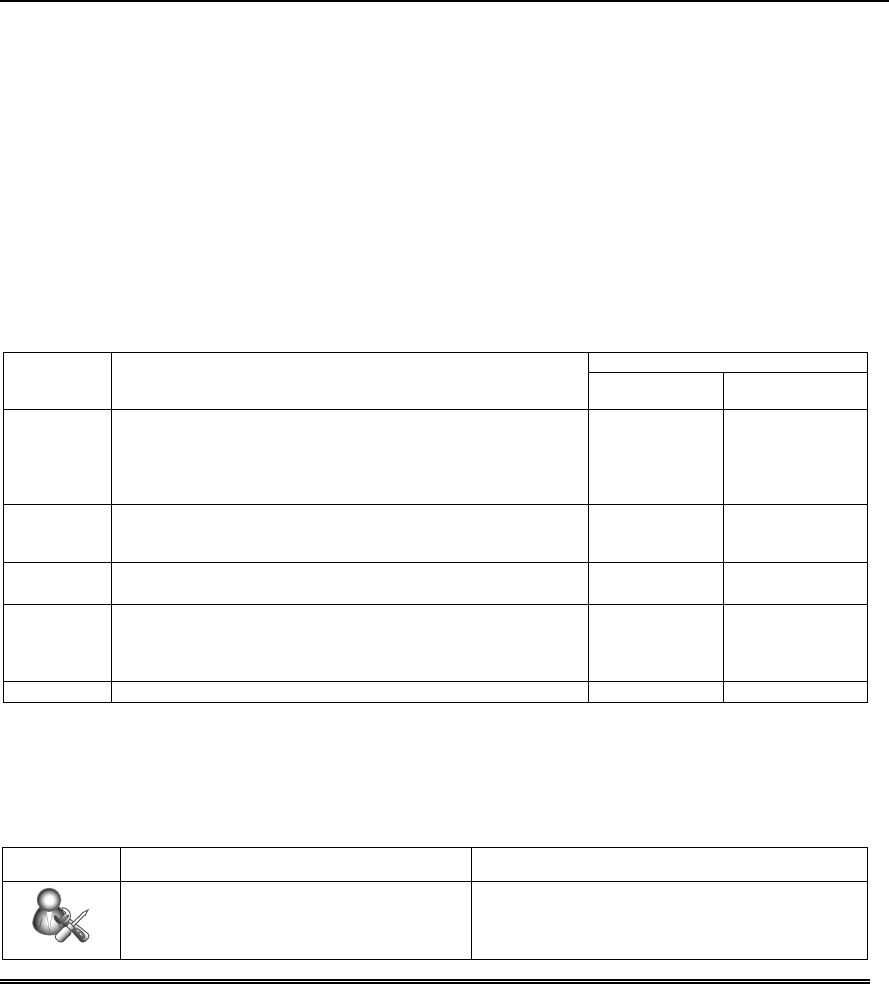
27
User System Setup
User Setup provides access to Add a User, Delete a User, and Edit a User.
User Code Setup
Each user must be assigned a name with a corresponding 4-digit user code in order to gain access to
various features and functions. The keypad can hold the identity for 10 Users in its memory. If additional
Users are needed, define the additional Users using the Console Emulation Mode.
Users for the system are programmed in a central user setup location that provides the specific questions
for authorization levels assigned to different users. You may want these users to be the same, but there
are situations in which you may want a user to have limited capabilities. These capabilities are defined by
the Authority Level assigned to each user.
Authority Levels
Authority levels define the system functions a particular user can perform. Depending on the authority
assigned to you, there are certain system functions you may be prohibited from performing. The following
information describes the authority levels available in the keypad and provides the equivalent authority
level name found in your alarm system manuals. The authority levels available in the keypad are as
follows:
Equivalent System Name Keypad
Authority
Level
Functions Residential
Systems
Commercial
Systems
Installer Can perform all security functions except can only disarm if
code was used to arm, can change Master Code, cannot
change other user codes, can access the Central Station
Screen options
Note: This authority level cannot be assigned using the keypad.
Installer Installer
Master Can perform all security functions, add/delete users in assigned
partition, program scheduled events, and change partition
master code.
Partition Master Level 1 Master
Normal Perform security functions (arm, disarm) Standard User Level 3
Operator A
Guest Can arm the system in assigned partitions, but cannot disarm
the system unless the system was armed with this code.
Note: Do not assign this level if Quick Arm is enabled in the
system.
Guest Level 4
Operator B
No Access Used to restrict access to a partition. N/A N/A
Note: The authorized code for deleting, adding, and editing users is dependent upon the alarm panel you
are interfacing with. Check your alarm panel Installation and Setup Guide to determine who can delete, add,
and edit users.
User Setup
How to Add a User
To add a user, from the "Home" screen press the Setup icon, and do the following:
ICON ACTION NOTES
1. From the "Home" screen, press the
Setup icon.
2. Press the System Setup icon.
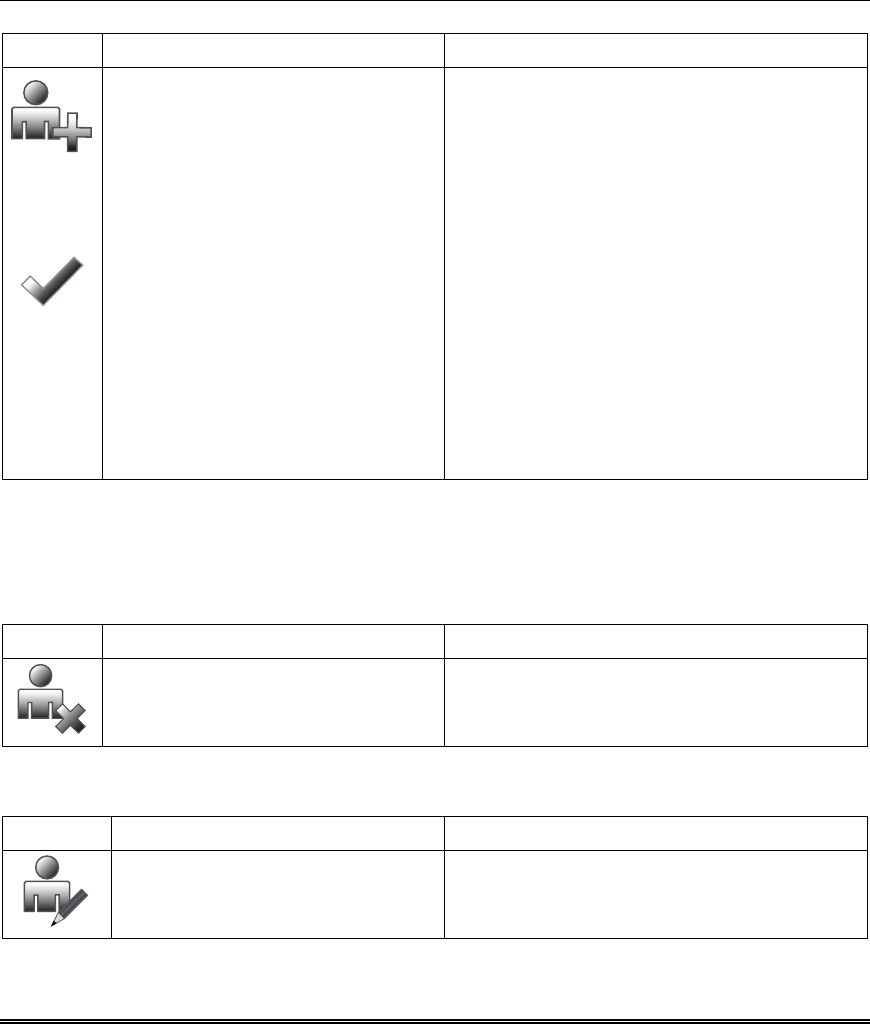
User System Setup (cont’d)
28
ICON ACTION NOTES
3. Press the USER SETUP icon.
4. Press the ADD USER icon and
enter your Authorized Code.
5. Press the box next to Enter User
Name.
6. Type in the user name (6 characters
max.; no spaces between characters)
and press the OK icon.
7. Press the box next to User Number
and enter an “available” (3-digit) user
number; press the OK icon.
8. Press the box next to Enter User
Code, enter the 4-digit User Code for
this user and press the OK icon.
9. Press the box next to RF Button
Zone (if used); enter the 3-digit RF
Button Zone for this user.
10. Press the Save icon.
Use the Data Entry Keyboard to enter all required
information.
Enter the user name (6 characters max.; no spaces
between characters) and press the GO icon.
• Press the Up Arrow key to switch to capital letters
• Press the X key to delete
• Press the ABC/.?123 key to switch between numerals
and symbols/characters.
• Press GO to return to the “Add User” screen.
Available user numbers:
For Residential enter a number from 002-049.
For Commercial enter a number from 002-250.
If assigning this user to wireless key, enter one of the
zone numbers of the keyfob (the wireless key must be
programmed first before it can be assigned to a user).
How to Add an Existing User to a Second Keypad
After adding a user to the first keypad, the same user can be added to a second keypad. From the
second keypad go to “User Setup” and enter the same user name and same user code (refer to “How to
Add a User” above). The second keypad will automatically update the user information. Press Save.
How to Delete a User
Delete a User as follows:
ICON ACTION NOTES
1. Select the User you want to delete.
2. Press the DELETE USER icon.
3. Enter your Authorized Code.
4. Press the appropriate icon.
Three selections are available: add a user, edit a user,
or delete a user.
The Confirm Delete screen is displayed.
How to Edit a User
Note: You cannot edit a User name or User number. To modify a User name or User number, you must
delete the User and re-enter the User. Edit a User as follows:
ICON ACTION NOTES
1. Press the EDIT USER icon.
2. Enter your Authorized Code.
3. Select the options needed for this
user and press Save.
Three selections are available: add a user, edit a user,
or delete a user.

User System Setup (cont’d)
29
Time/Date Setup
You can set the time and date from the Set Time & Date screen.
When the time is set it is stored in the keypad and sent to the control panel when you press Apply and
answer Yes to the following prompt. Additionally, when using the keypad with a residential panel, the
panel downloads its time into the keypad once an hour after the clock is set.
If the Get Time icon is pressed, the keypad downloads the time and date from the control panel and
exits the Set Time & Date screen. Note: This icon appears with residential panels and may not
appear with all commercial panels.
Setting Daylight Savings Time
To set the daylight savings time, from the "Home" screen do the following:
ICON ACTION NOTES
1. Press Setup and the System
Setup icon.
2. Press the Time/Date Setup icon
and enter your Authorized Code.
3. Press the DST icon if you want
daylight savings time to affect your
system clock.
4. Set the “Start DST” time and then
the “End DST” time by pressing the
Month, Weekend and Hour that you
want DST to start.
5. APPLY saves the settings.
If DST On (Daylight Savings Time) is selected, the
keypad adjusts for Daylight Savings time at the month,
week and time chosen.
Make sure "DST" On is checked to enable this feature.
Setting Current Time and Date
To set the current time, do the following:
ICON ACTION NOTES
1. Press the Time/Date Setup icon; enter
your Authorized Code.
2. Press the Month "arrow", and select the
current month.
3. Press the Year that is being displayed
and enter the current year.
4. Press the Hour that is being displayed
and enter the current hour.
5. Press the Minutes that is being displayed
and enter the current minute.
After each selection the window closes
automatically and the selection is displayed.
The selected date is highlighted on the screen.
Select if you want a 12-hour or 24-hour format
for your time display by pressing the circle to the
left of the 12 Hour display.
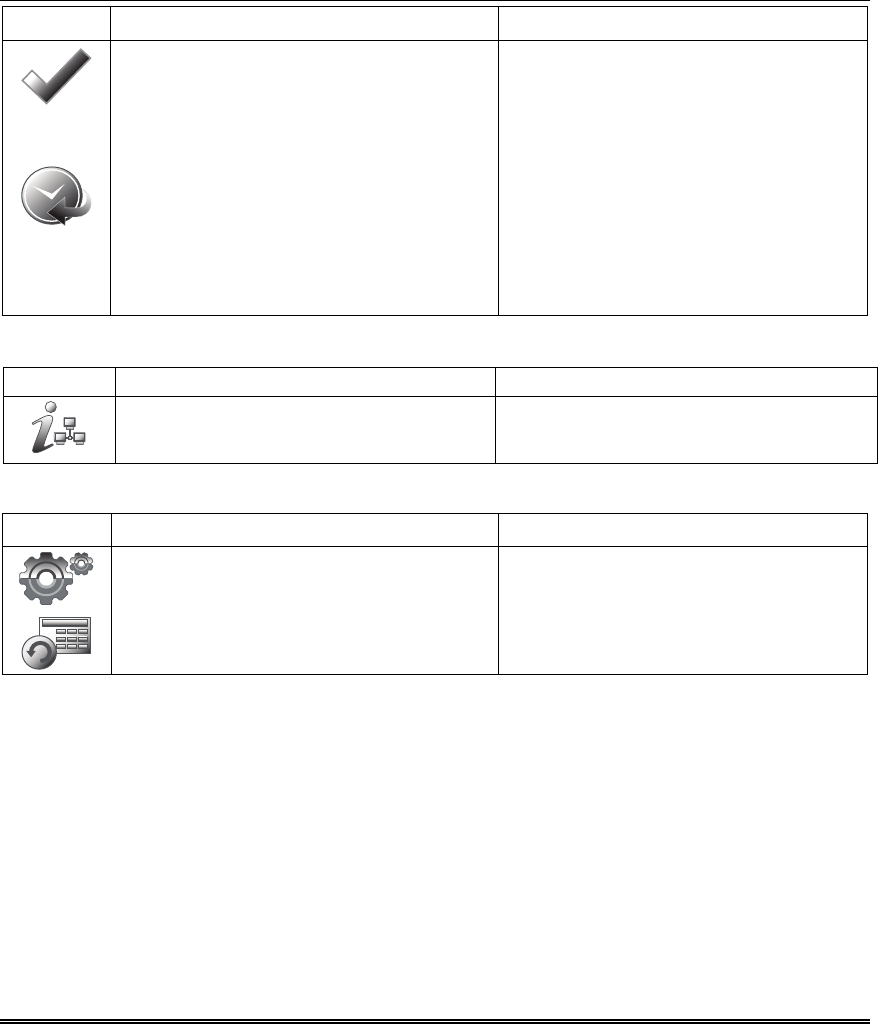
User System Setup (cont’d)
30
ICON ACTION NOTES
6. Select AM or PM. (Each depression
switches the AM/PM display).
7. Press the MMDDYY “arrow”, and select a
format for which you want the year to be
displayed.
8. Press Apply.
9. Press the Get Time icon to have the
keypad download the time and date from
the control panel and exit the Set Time &
Date screen.
Yes saves the time changes in your security
system.
No saves the changes to the keypad only.
A confirmation screen is displayed.
Note: A Yes response is recommended.
System Information
To view the latest software/firmware version installed on your system, do the following:
ICON ACTION NOTES
1. From the "Home" screen, press the
Setup icon.
2. Press the System Info icon.
The Software and Firmware Version is displayed
on the left side of the screen.
Keypad Reset
To access Keypad Reset do the following:
ICON ACTION NOTES
1. From the "Home" screen, press Setup
and the System Setup icon.
2. Press the Advanced Setup icon.
3. Enter your Authorized Code.
4. Press the Keypad Reset icon.
If the keypad requires resetting, press OK and
the keypad resets. If Cancel is selected, keypad
is not reset.
Advanced Setup
The Advanced Setup screen allows access to Keypad Reset, Keypad Test, Night Setup and Output
Setup menus.
Keypad Test
A series of diagnostic tests are provided that allows verification of correct operation of the keypad and
its connections to the security system. There are a total of five diagnostic tests; LCD Display Test,
Audio Test, LED Test, Calibration Test, and Z-Wave Test.
Performing Diagnostic Tests
Select any diagnostic test from the “Diagnostics” screen by pressing its associated Test icon. All or any
individual test may be run when you access the “Diagnostics” screen; however, each test must be
performed one at a time. At any time when a test is not being performed, you can press:
• back to return to the previous screen, or
• home to return to your home page.
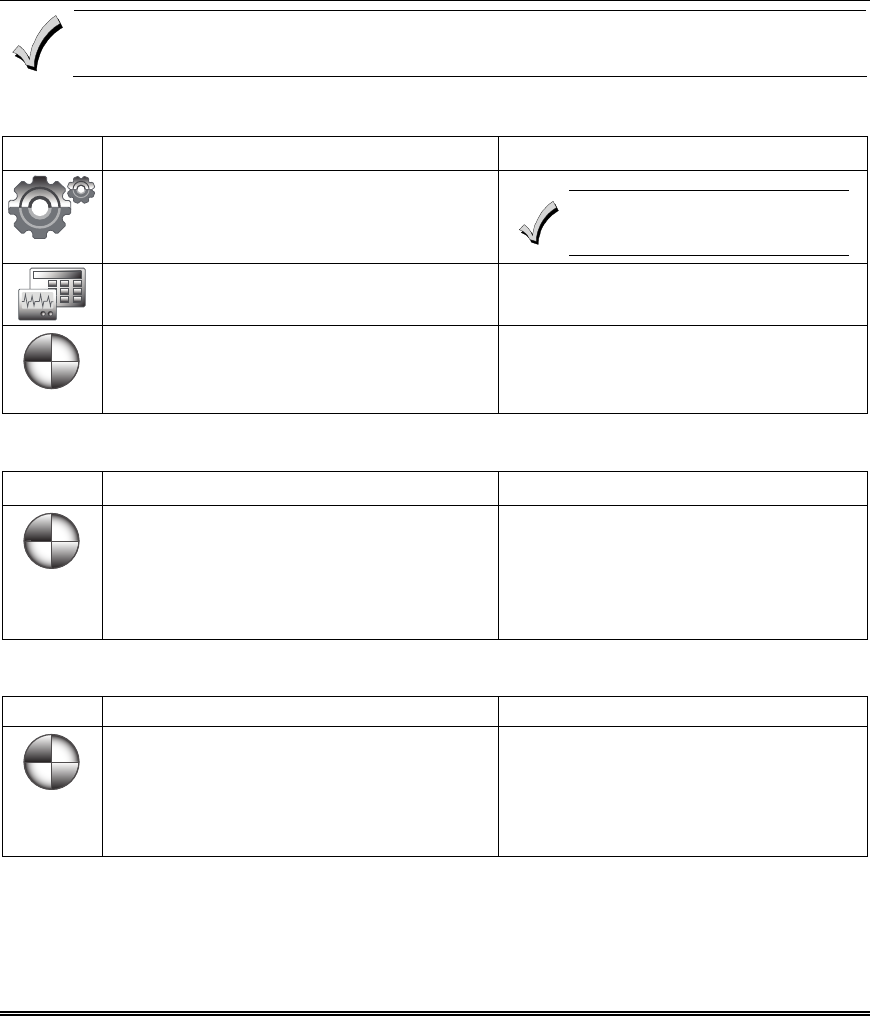
User System Setup (cont’d)
31
Once the Diagnostics screen is exited, subsequent entry to this screen displays all test options as
"Not Performed."
LCD Display Test
Perform the LCD Display Test as follows:
ICON ACTION NOTES
1. Press the Advanced Setup icon.
2. If applicable, enter your Authorized Code.
The Emergency screen cannot be
accessed while running the LCD
Display Test.
3. Press the Keypad Test icon.
4. Press the LCD Display Test icon; a series
of screens appear.
After each type of display, you are asked if
the display was proper.
If the response to all questions is yes, the LCD
Display Test message area of the Diagnostics
screen displays “Passed”.
Audio Test
Perform the Audio Test as follows:
ICON ACTION NOTES
1. Press the Audio Test icon; "Testing.." is
displayed while beeps sound from the
speaker.
At the conclusion of the test, a pop-up "Confirmation
Window" is displayed with the question "Did you
hear Beeping?"
When you press Yes, "Passed" is displayed in
the test status column on the "Diagnostics"
screen.
When you press No, "Failed" is displayed in the
test status column on the "Diagnostics" screen.
LED Test
Perform the LED Test as follows:
ICON ACTION
1. Press the LED Test icon; "Testing.." is
displayed while the 3 LEDs light
sequentially, top to bottom (red, green,
yellow), 5 times.
At the conclusion of the test, a pop-up
"Confirmation Window" is displayed with the
question "Did you see chasing LED pattern?"
If you press Yes, "Passed" is displayed in the
test status column on the "Diagnostics" screen.
If you press No, "Failed" is displayed in the test
status column on the "Diagnostics" screen.
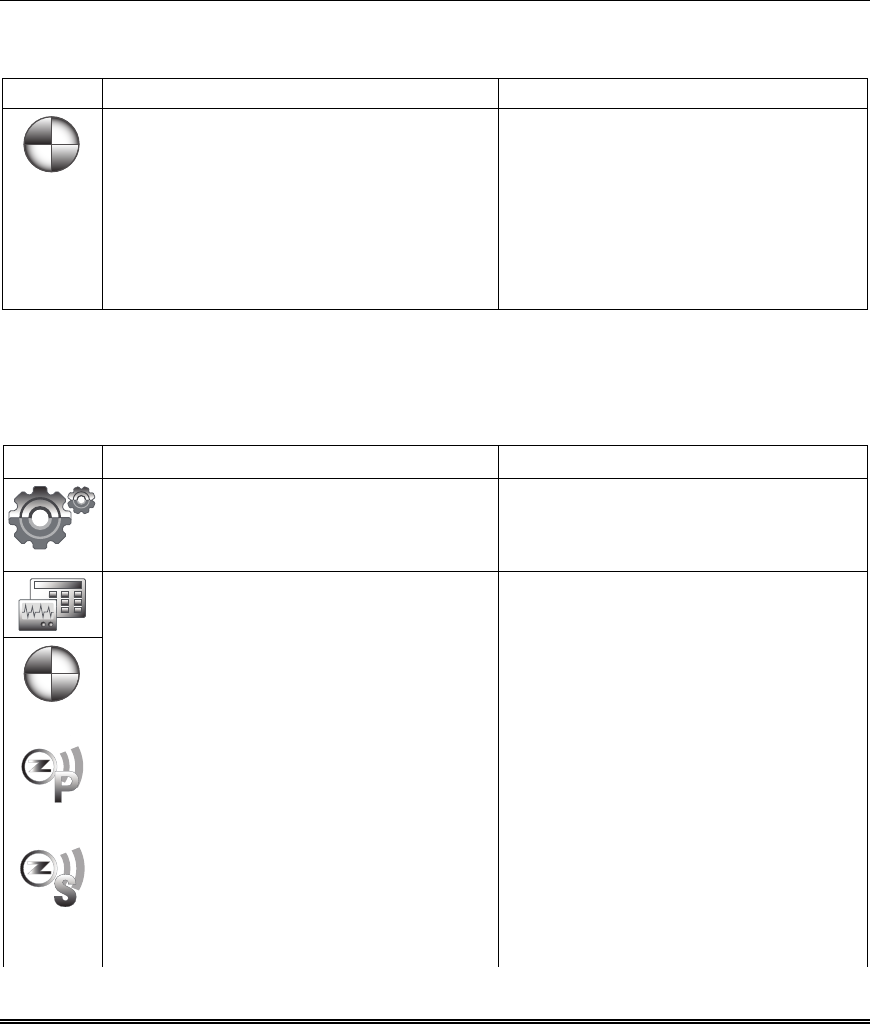
User System Setup (cont’d)
32
Calibration Test
If the Touch Screen requires recalibration, do the following:
Z-Wave Test
This procedure is for Z-Wave test purposes only.
Role shifting is the process of shifting primary and secondary controllers. The secondary controller
becomes the primary controller with the ability to enroll Z-Wave devices. This is useful when the
primary controller is in a fixed location and the Z-wave device is not easily accessible (but within Z-
Wave range). To perform the role shifting Z-Wave Test, do the following:
ICON ACTION NOTES
1. Press the Advanced Setup icon.
2. Enter your Authorized Code.
Note: The status of the controller can only be
changed from Primary to Secondary controller
when no devices are enrolled.
Use the delete device or reset controller function
to remove enrolled devices.
3. Press the Keypad Test icon.
4. With the status of the controller in the “P”
(Primary) state, press the Z-Wave Primary
Controller Shift to Secondary icon.
5. To shift the primary controller role to a
handheld controller, follow the handheld
controller manufacturer’s instructions.
When the pop-up message disappears and
controllers have shifted successfully, Z-Wave
devices can be enrolled from this controller.
6. Shift the Tuxedo Touch back to the
primary controller after enrolling Z-wave
devices. First, initiate the role shift on the
handheld controller from primary to
secondary referring to manufacturer’s
instructions. Then, press the Z-Wave
Secondary Controller Shift to Primary icon
on the keypad.
Select from two main categories of tests:
• Z-Wave Role Shifting: Primary to Secondary
and Secondary to Primary.
• Z-Wave Basic Command: Set On or Off.
A pop-up window is displayed with the following:
“Role Shift is in progress, please wait ...
This Z-Wave controller shift function is for
evaluation only now. This primary controller
is shifting to the secondary.
The Shift is completed when the pop-up window
disappears.
Note: The Z-Wave Primary Controller Shift to
Secondary icon is inactive when the Tuxedo
Touch keypad becomes the secondary
controller.
ICON ACTION
1. Select the Calibration icon and using a
stylus, follow the screen directions by
pressing a series of crosshairs (+) and boxes
(❏
❏❏
❏) on the screen until done.
2. If the test was successful, press OK; the
screen returns to the Keypad Test screen.
3. If the test was unsuccessful, choose to
Retry, Ignore or Exit.
A pop-up message displays:
Touch screen calibration
Touch crosshair to calibrate
If the Calibration test was successful, a
confirmation screen appears stating:
“Congratulations Calibration Success”
If the test was unsuccessful, an error message
appears indicating the Part of the screen that
failed and stating: “Calibration failure, do you
want to retry?”
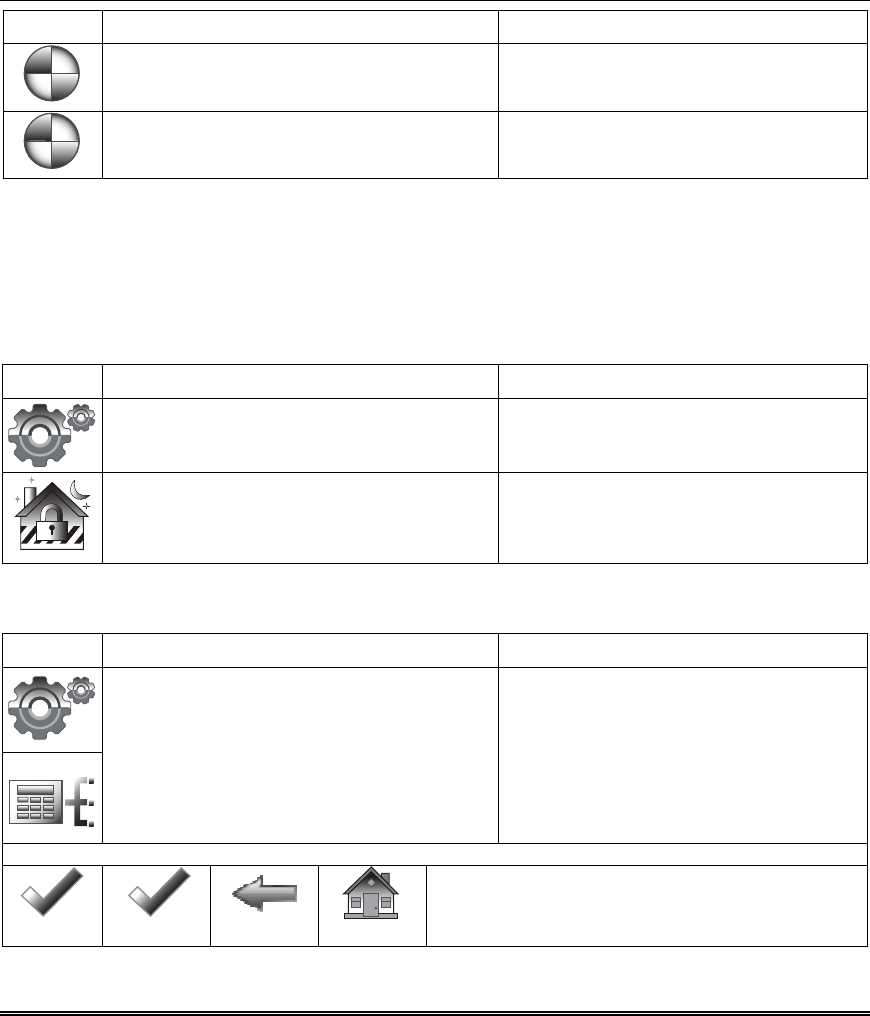
User System Setup (cont’d)
33
ICON ACTION NOTES
7. Select the Z-Wave Basic Command Set
On icon to turn On all lamp modules,
dimmer On/Off switches and receptacles.
Note: This command does not control door locks
or any other security enabled devices.
8. Select the Z-Wave Basic Command Set
Off icon to turn Off all lamp modules,
dimmer On/Off switches and receptacles.
NIGHT Setup Function
The NIGHT function can be set to arm the system in one of five arming modes:
• Away - Arms all zones with entry delay.
• Stay - Arms perimeter zones with entry delay.
• Instant - Arms perimeter zones without entry delay.
• Night (Residential Panels Only) – Arms all perimeter zones plus all zones listed in Zone List 5.
• Maximum - Arms all zones without entry delay. Not to be used for ANSI/SIA CP-01 installations.
To set the NIGHT function, do the following:
ICON ACTION NOTES
1. Press the System Setup and Advanced
Setup icon.
2. Enter your Authorized Code, if required.
3. Press the Night Setup icon.
4. Select the arming mode to be activated
when NIGHT is selected on the "Arming"
screen.
Apply accepts the setting.
Back cancels your selection.
Output Setup Function
The Output Setup function allows you to disable Output selection. There are a maximum of 18 outputs
that can be enabled or disabled. To set the Output Setup function, do the following:
ICON ACTION NOTES
1. Press the System Setup and Advanced
Setup icon.
2. Enter your Authorized Code, if required.
3. Press the Output Setup icon.
4. Highlight the Output function number on
the screen and press the Disable or Enable
button to change the setting.
5. Press Apply.
This is a local setting for the graphic keypad. If
user has the maximum number of keypads on
the system, and wants to disable the same
output for all, each keypad needs to be set
individually.
A confirmation window is displayed stating:
“Information
Settings saved”
Press OK to save the setting
Output Setup Icons
Apply
OK
Back
Home
If the Back icon is pressed, a confirmation window appears
stating:
“Output Settings changed. Do you want to save new
settings?” Select Yes or No.
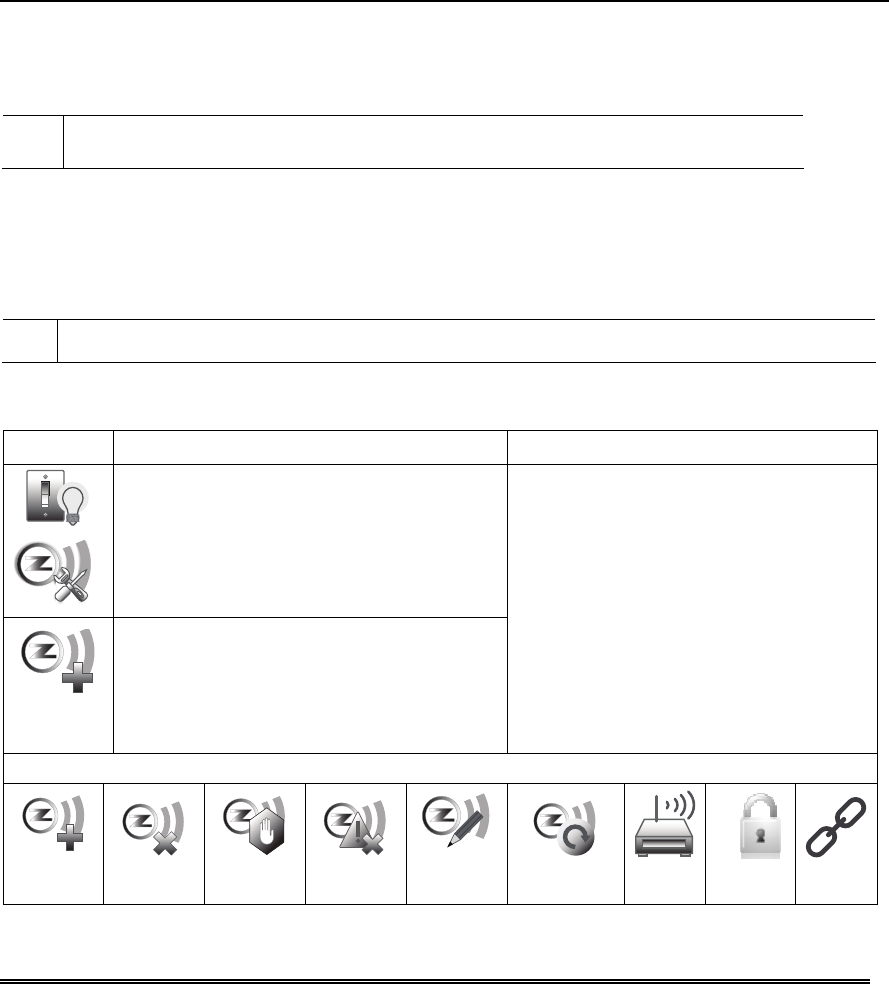
34
Automation
The Automation feature allows access to Group Setup, Scene Setup, Z-Wave Setup and the Output
List.
WARNING: Automation is intended for lifestyle convenience. Do not use automation for life safety and
property protection.
UL • Automation functionality is supplementary only and has not been evaluated by UL.
• Z-Wave applications have not been evaluated by UL.
Including/Adding Z-Wave Devices
Before a device will work in the home control network, it must be “Included” (added) into the network.
Each device must be installed according to the manufacturers’ instructions and in their final location
and turned on prior to adding it into the network. Follow the instructions below to Include a Z-Wave
enabled device into a home control network using the Tuxedo Touch keypad and follow the instructions
in the Z-Wave device User Guide for your specific device.
UL Access control functionality has not been evaluated by UL and may not be used in UL Listed
applications.
Include/Add a Light, Switch or Outlet Module
To include a Z-Wave Light, Switch or Outlet module, do the following:
ICON ACTION NOTES
1. At the Tuxedo Touch Keypad:
a) Press the Automation icon from the
“Home” screen and then press the
Z-Wave Setup icon to display the
“Z-Wave Device Management” screen.
b) Press the Z-Wave Include/Add icon.
2. At the device Module:
a) Press the Function Key on the device.
Note: Z-Wave light modules may vary; follow the
instructions in the User Guide for your specific
device to include properly.
• If a dimmer module was added, an On/Off
button and a slide bar (to control the dimmer)
are displayed.
• If an on/off light, appliance, switch or outlet
module was added, an On/Off button (to
control the device) is displayed.
The keypad displays a series of messages:
“Start add device.
Please press function key on device”
“Adding Controller Unit”
“Adding Slave Unit”
“Device added successfully”
Z-Wave Device Management Icons
Include/
Add
Exclude/
Delete
Abort
Remove
Failed
Edit
Reset Default
Router Security
Link
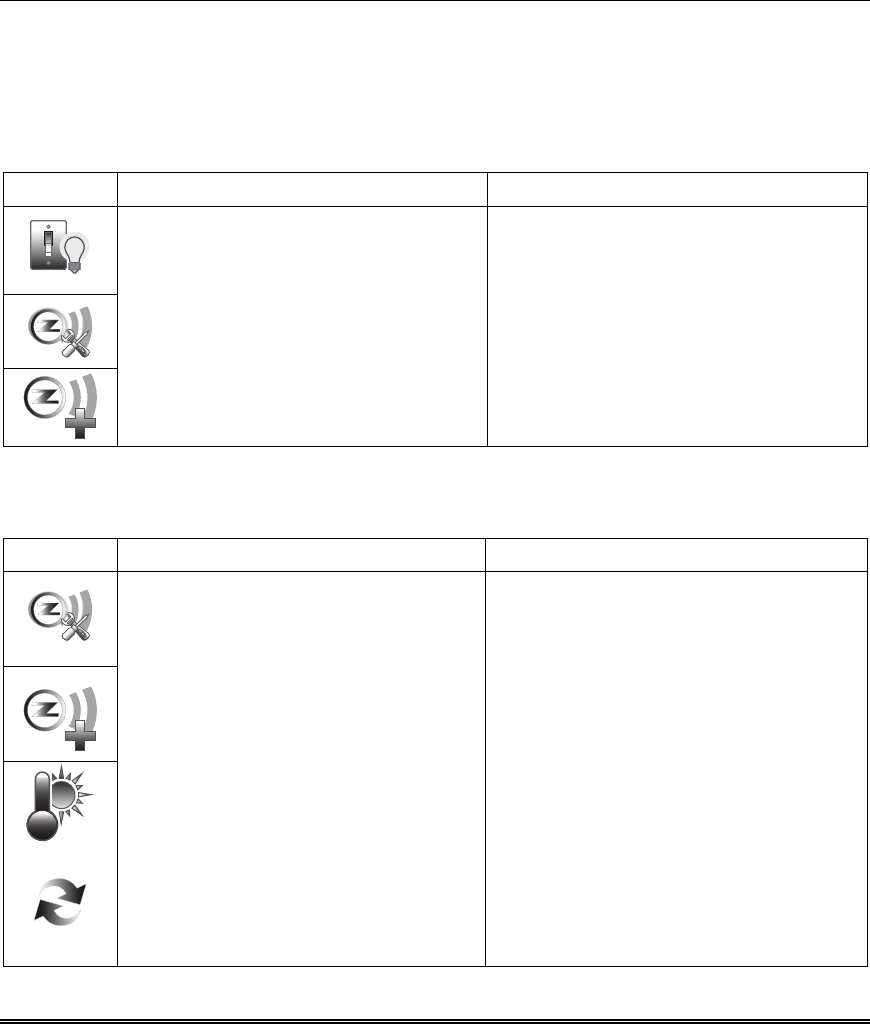
Automation (cont’d)
35
Include a Door Lock
Assemble the Z-Wave door lock (if required); install batteries and connect necessary cables (refer to the
Door Lock’s Instruction Guide). Enroll the door lock adjacent to the keypad and mount within the
proper Z-Wave range (refer to the “Important Notes” section for further information).
NOTE: Program the user code in the control panel prior to programming that user code into the door
lock. User Codes must be 4-digits.
Include a door lock device as follows:
ICON ACTION NOTES
1. At the Tuxedo Touch Keypad:
a) Press the Automation icon from the
“Home” screen and then press the
Z-Wave Setup icon to display the
“Z-Wave Device Management” screen.
b) Press the Z-Wave Include/Add icon.
2. At the door lock:
a) Program the selected user code from
the panel; refer to Door Lock User
Guide.
Note: Door lock devices may vary; follow the
instructions in the
Users Guide
for your specific
door lock to include properly and to program a
new user code.
The keypad displays a series of messages:
“Please press function key on device”
“Adding to Security Network”
“Device added successfully”
Note: If software is upgraded on the Tuxedo
Touch keypad, re-included the door lock and re-
set the user code in the door lock.
Follow the screen instructions to complete the
inclusion.
Include a Honeywell Thermostat
Install a Honeywell Thermostat according to the manufactures instructions. Device should be mounted
in the final location and tested before adding it to the system.
To include a Honeywell Thermostat into a Z-Wave network, do the following:
ICON ACTION NOTES
1. At the Tuxedo Touch Keypad:
a) Press the Automation icon from the
“Home” screen and then press the
Z-Wave Setup icon to display the
“Z-Wave Device Management” screen.
b) Press the Z-Wave Include/Add icon.
2. At the Z-Wave thermostat:
a) Select Thermostat; set the Time and
Date.
b) Follow the instructions in the
thermostat Installation Guide for
“Z-Wave inclusion”.
c) To complete inclusion, press Done.
d) Press Exit on the thermostat to
return to normal operation.
3. At the Tuxedo Touch Keypad:
a) To verify activation, press the Back
icon and wait 30 seconds.
Note: If installing another brand of thermostat,
follow the instructions in the
Users Guide
for that
specific thermostat to include properly.
Some thermostats do not update temperature
status automatically (i.e., Wayne Dalton).
IMPORTANT: Honeywell is not responsible for
property damages due to improper setting of the
thermostat modes.
The keypad displays a series of messages:
“Please press function key on device”
“Adding Controller Unit”
“Adding Slave Unit”
“Device added successfully”
Follow the screen instructions to complete the
inclusion.
Press the Refresh icon; the device is displayed.
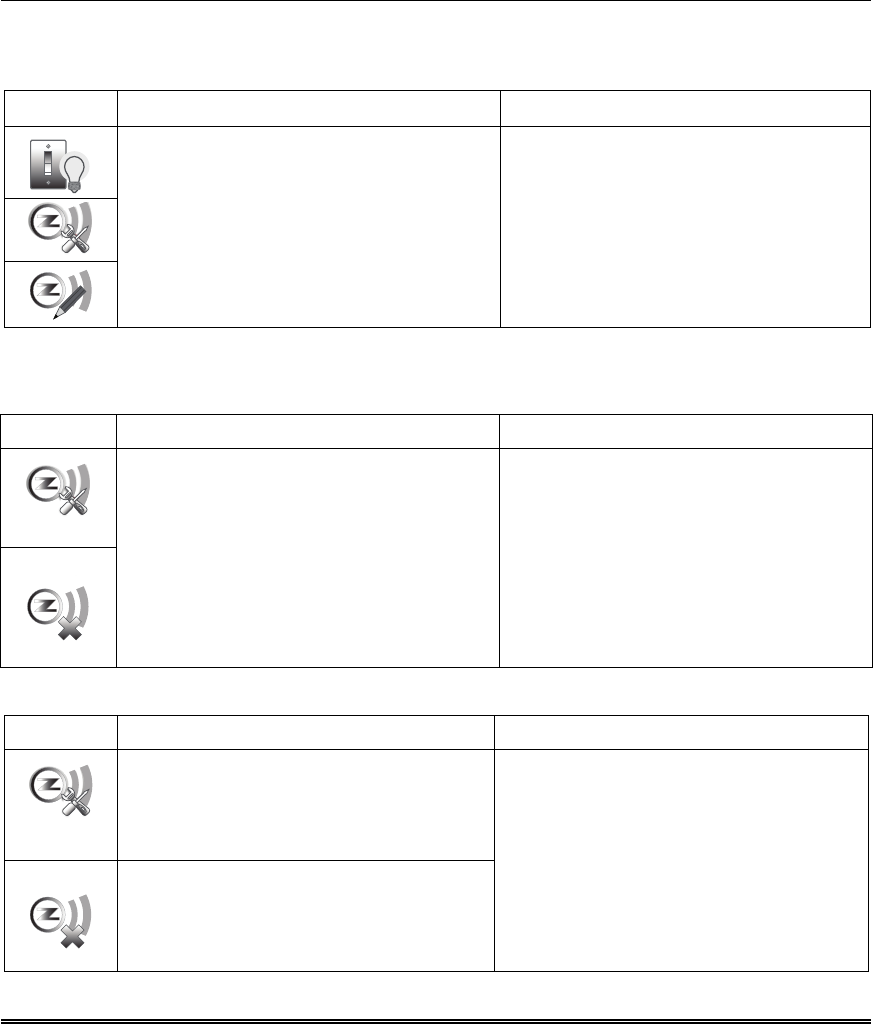
Automation (cont’d)
36
Editing Z-Wave Device Names
Edit a Device Module Name
To edit a device name, do the following:
Exclude/Delete Z-Wave Devices
Exclude a Light, Outlet, or Switch Module
To exclude a device from the Z-Wave network, do the following:
ICON ACTION NOTES
1. At the Tuxedo Touch Keypad:
a) Press the Automation icon from the
“Home” screen and then press the
Z-Wave Setup icon to display the
“Z-Wave Device Management” screen.
b) Highlight the device to exclude and
press the Z-Wave Exclude/Delete icon.
2. At the device module:
a) Press the Function Key to exclude
the device from the keypad.
Z-Wave Exclude/Delete -clears the node from
the keypad and resets device to the default
setting.
Notes:
• If the device is not excluded, refer to the “
Z-
Wave Troubleshooting”
section.
• To remove a defective device, refer to the
Z-
Wave Troubleshooting
section.
Exclude a Door Lock Device
To exclude a door lock module from the Z-Wave network, do the following:
ICON ACTION NOTES
1. At the Tuxedo Touch Keypad:
a) Press the Automation icon from the
“Home” screen and then press the Z-
Wave Setup icon to display the “Z-
Wave Device Management” screen.
b) Highlight the device to exclude and
press the Z-Wave Exclude/Delete icon.
2. At the door lock:
a) Press the Function Key to exclude the
device from the keypad.
Z-Wave Exclude/Delete-clears the node from the
keypad and resets device to the default setting.
Notes:
• If the device is not excluded, refer to the “
Z-
Wave Troubleshooting
” section.
• When excluding the door lock, the user code
associated with the door lock will remain in the
system. If needed refer to the panel
Installation
Instructions
on how to exclude this user code.
• To remove a defective device, refer to the “
Z-
Wave Troubleshooting
” section.
ICON ACTION NOTES
1. At the Tuxedo Touch Keypad:
a) Press the Automation icon from the
“Home” screen and press the Z-Wave
Setup icon to display the “Z-Wave
Device Management” screen.
b) Highlight the device name and press
the Z-Wave Edit icon.
c) On the “Data Entry” keyboard, press
Clear and enter a new name; press GO.
Enter the new device name by entering it on the
data entry keyboard.
• Press the Up Arrow key to switch to capital
letters
• Press the X key to delete
• Press the ABC/.?123 key to switch between
numerals and symbols/characters.
• Press GO to return to the “Add User” screen.
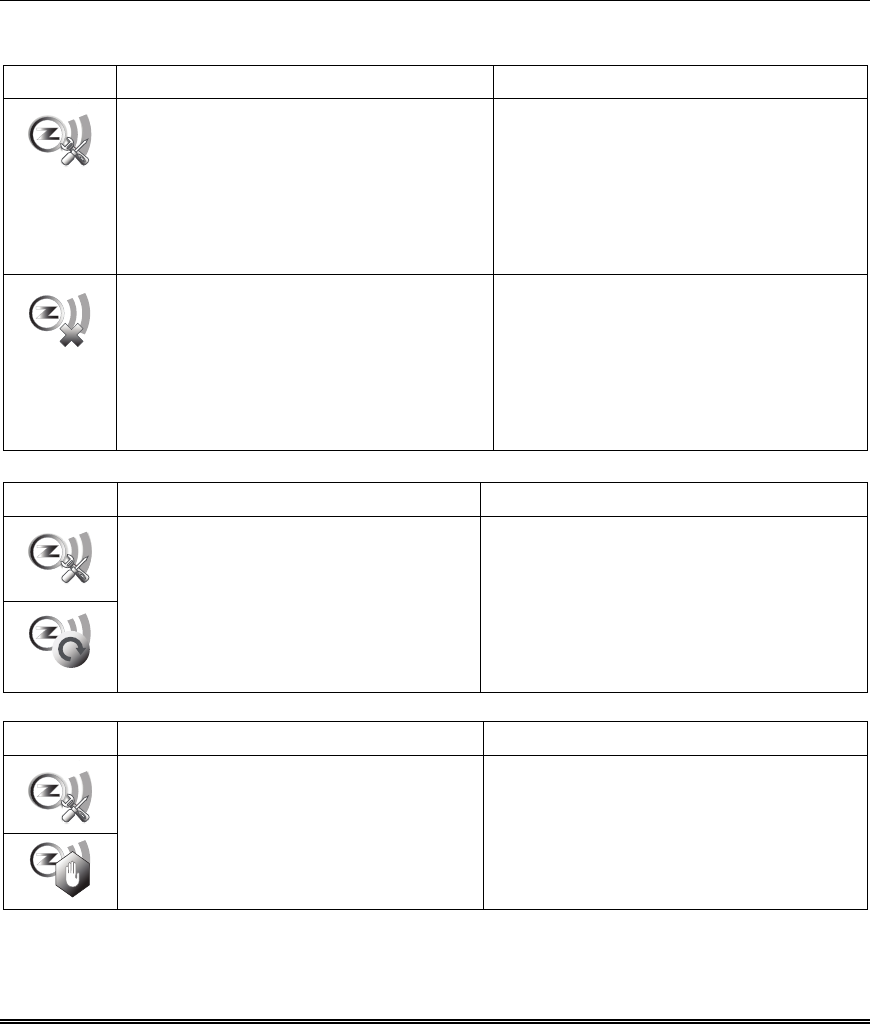
Automation (cont’d)
37
Exclude a Honeywell Thermostat
To exclude a Honeywell Thermostat from the Z-Wave network, do the following:
ICON ACTION NOTES
1. At the Tuxedo Touch Keypad:
a) Press the Automation icon from the
“Home” screen and then press the
Z-Wave Setup icon to display the
“Z-Wave Device Management”
screen.
b) Highlight the thermostat and press
the Z-Wave Exclude/Delete icon.
Note: Honeywell is not responsible for property
damages due to improper setting of the
thermostat modes.
Z-Wave Exclude/Delete -clears the node from
the keypad and resets device to the default
setting.
2. At the thermostat:
a) Follow the instructions in the
thermostat Installation Guide under
“Installer setup” to “Remove a Z-
Wave Network Connection”.
b) Once the exclusion process is
complete, press Done and the
thermostat is excluded.
Notes:
• If the device is not excluded, refer to the “
Z-
Wave Troubleshooting
” section.
• To remove a defective device, refer to the “
Z-
Wave Troubleshooting
” section.
Exclude All Z-Wave Devices
ICON ACTION NOTES
1. At the Tuxedo Touch Keypad:
a) Press the Automation icon from the
“Home” screen and then press the Z-
Wave Setup icon to display the “Z-
Wave Device Management” screen.
b) Press the Z-Wave Reset icon to
delete all devices from the controller.
c) Select Continue or Cancel.
The message is displayed:
WARNING!! This Z-WAVE controller is about to
be factory defaulted and will loose all devices
in the enrolled list. All Z-WAVE devices must
be re-enrolled.
Abort a Z-Wave Action
ICON ACTION NOTES
1. At the Tuxedo Touch Keypad:
a) Press the Automation icon from the
“Home” screen and then press the Z-
Wave Setup icon to display the “Z-
Wave Device Management” screen.
b) Press the Z-Wave Abort Operation
icon to abort that process.
If inadvertently a wrong process is selected, (i.e.,
add, delete, or remove failed device) press the Z-
Wave Abort icon to abort that process.
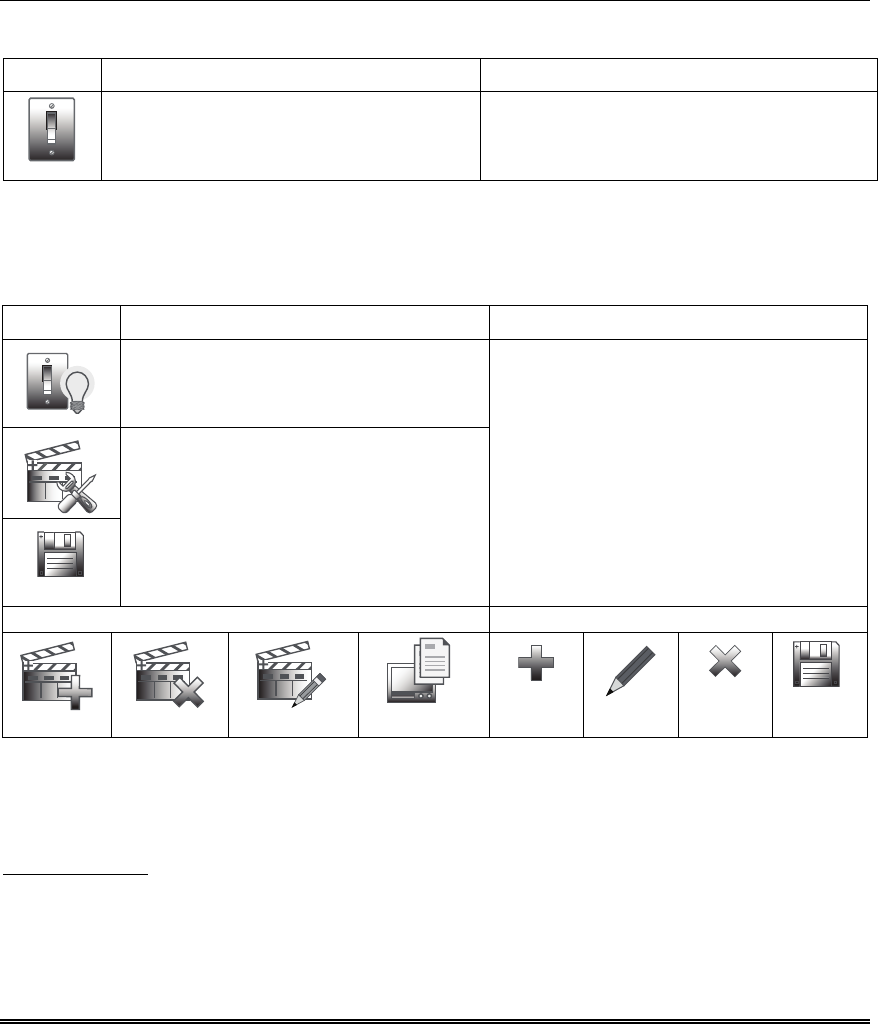
Automation (cont’d)
38
Output List
To access the Output List, from the “Home” screen, do the following:
ICON ACTION NOTES
1. Press the Automation and Output icons.
2. Enter your Authorized Code.
3. Use the OFF or ON button to control
outputs.
Create a Scene
The Scene feature is used to control a single device, or multiple device control commands that function
according to pre-set “Conditions”, “Triggers”, and “Actions”. When a trigger/condition occurs, the action
is executed. A total of 10 Scenes can be created. Follow the steps below to define one or more device
actions for a Scene and refer to the “Scene Rules” below.
Scene Rules
• Each Trigger event can have up-to 3 Actions.
• A Trigger event and Condition cannot be the same (i.e., if setting a Trigger event for SECURITY,
you cannot set a SECURITY Condition).
• A total of 10 Scenes can be created.
To create a Scene:
Step 1: Define a Trigger event (i.e., SECURITY: System Armed).
Step 2: Define an Action to happen when the Trigger event occurs (i.e., LIGHT: Off).
Step 3: If required, define a Condition for the Trigger event to occur (i.e., TIME: Mon-Fri).
ICON ACTION NOTES
1. At the Tuxedo Touch Keypad:
a) Press the Automation icon and then
press the Scene Setup icon to display
the “Scene Management” screen.
b) Press the Add icon.
c) Press the Scene Name box, enter a
Scene Name and press OK.
d) Select a “Condition”, “Trigger”, and
“Action” that you want to occur for
this Scene and after each selection is
complete, press Save after each step!
INFORMATION: Scenes must have at least a
trigger and 1 action to work. Enter the event to
trigger the scene in the Trigger section. The
Condition section is optional.
Use the Data Entry Keyboard to enter all required
information.
• Press the Up Arrow key to switch to capital
letters
• Press the X key to delete
• Press the ABC/.?123 key to switch between
numerals and symbols/characters.
• Press GO to return to precious screen.
Press Delete to cancel, or Edit to change your
selections.
Scene Icons Condition/Trigger/Action Icons
Add Scene
Edit Scene
Delete Scene
Scene Log
Add
Edit
Delete
Save

Automation (cont’d)
39
Add a Trigger
In the “Trigger” box, press the Add icon.
Press the TIME button and Set the occurrence to Repeated, or Once. If “Repeated” was selected,
choose the desired days of the week; or Enter Date for an occurrence that happens Once.
Press the SECURITY button and select a security mode: DISARM, AWAY, STAY, NIGHT (for
residential panels only) ..
Press the THERMOSTAT button to select the Thermostat Devices from the drop down menu. Use
the ABOVE and BELOW button to enter a set point temperature value or press the Temperature
Value box and enter 2 digits for the desired temperature. Note: Test thermostats first to ensure
proper function in the “Scene” feature.
Press the DOOR button to select a Door Device from the drop-down menu. Select LOCKED,
UNLOCKED or CODE UNLOCKED. Press Save.
Add an Action
In the “Action” box, press the Add icon.
Set the SECURITY mode to: DISARM, AWAY, STAY, NIGHT. Enter User Code, if required.
Press the LIGHT button and select a Light Device from the drop down menu; set the action to ON or
OFF.
Press the THERMOSTAT button and select a Thermostat Device from the drop-down menu. Press
the Set Mode button to set the Action to “Off”, “Heat”, or “Cool”. Press the Set Energy button and
select from “Normal” or “Saving” energy mode. Press the Set Point button and enter a set point value
for “Heat Point” and “Cool Point”. Note: Test thermostats first to ensure proper function in the
Scene feature.
Press the DOOR button and select a Door Device from the drop-down menu. Set the action to
LOCKS or UNLOCKS. Press Save.
Add a Condition
In the “Condition” box, press the Add icon.
Set the TIME: Set the occurrence to Repeated, or Once. Follow the screen instructions to select the
days of the week if “Repeated” was selected or “Enter Date” for an occurrence that happens Once.
Press the SECURITY button and select a security mode: DISARM, AWAY, STAY, NIGHT.
Press the THERMOSTAT button and select a Thermostat Device from the drop down menu. Use the
ABOVE and BELOW buttons to enter a set point temperature value or press the Temperature Value
box and enter 2 digits for the desired temperature. Note: Test thermostats first to ensure proper
function in the Scene feature.
Press the DOOR button and select a Door Device from the drop-down menu. Select LOCKED or
UNLOCKED. Press Save.
Notes:
1. Motorized door lock bolts physically lock and unlock when activated, but if the door lock installed is a
non-motorized type, activation allows the door to be manually unlocked without a key. See “Compatible
Devices” section for further information.
2. Some thermostats do not update temperature status automatically (i.e., Wayne Dalton).
3. When using a Kwikset Smartcode electronic deadbolt door lock (in a Scene that is programmed to
trigger when unlocked) the Scene does not trigger if using a key; enter a user code.
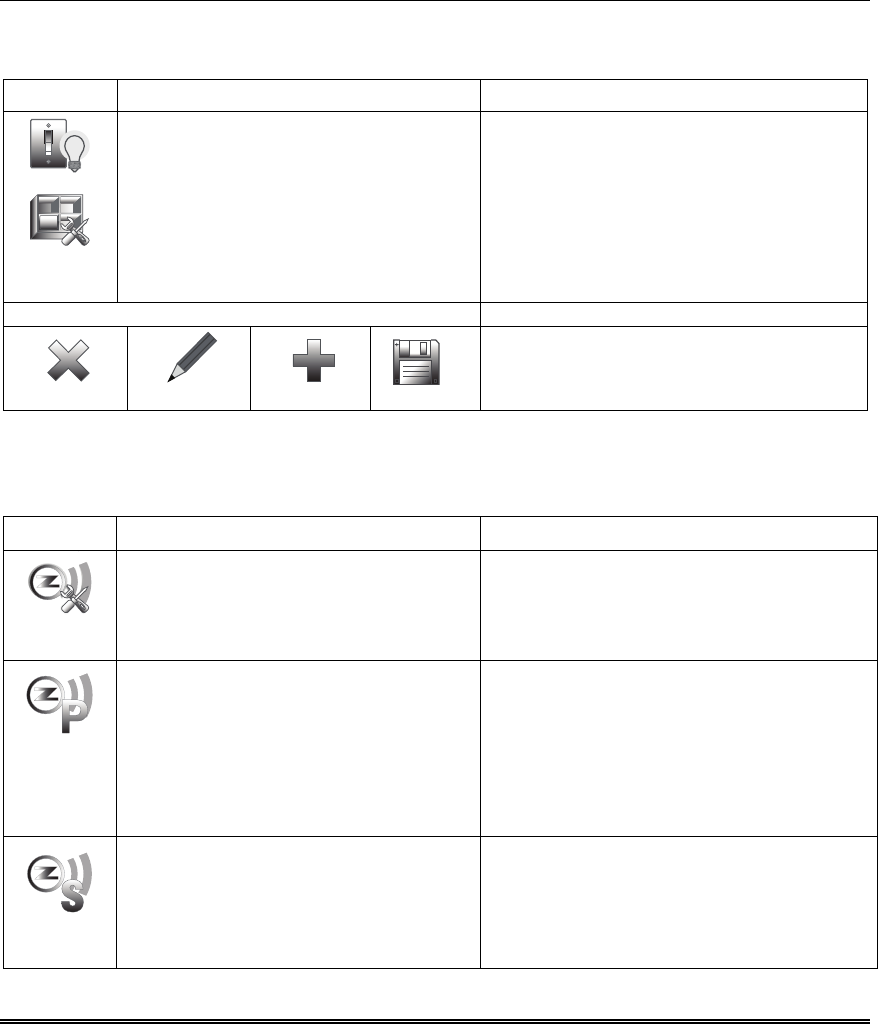
Automation (cont’d)
40
Create a Group
The Group Setup feature enables multiple devices to function as a group. Follow the procedure below to
create a Group.
ICON ACTION NOTES
1. Press the Automation icon and then
press the Group Setup icon.
2. Press the Add icon and enter a Group
Name on the “Data Entry” keyboard.
3. Press GO.
4. Highlight the device(s) from the list
that you want to add to this Group
and press the Save icon.
Group names (i.e., All, etc.) are displayed across
the top to the screen.
Use the Data Entry Keyboard to enter all required
information.
• Press the Up Arrow key to switch to upper case
letters
• Press the X key to delete
• Press the ABC/.?123 key to switch between
numerals and symbols/characters.
• Press GO to return to the previous screen.
Group Setup Icons
Delete
Edit
Add
Save
If settings were changed, a pop-up window
displays: Settings saved. Select OK to save.
Setting a Secondary Controller
After all Z-Wave devices have been included into the Primary Controller, the device information on the
Primary Controller can be downloaded to a Secondary Controller. Apply power to the Secondary
Controller and do the following:
ICON ACTION NOTES
1. On the Primary Controller:
a) Press the Automation icon from
the “Home” screen and then press the
Z-Wave Setup icon to display the “Z-
Wave Device Management” screen.
The message is displayed:
“Please remove all Z-wave devices from network
first”
2. At the Secondary Controller:
a) Remove any Z-Wave devices that
have been added.
b) Press the Z-Wave Primary icon
(located in the lower right side of the
screen).
c) Select Yes to change this keypad
to a Secondary Controller.
The message is displayed: “Scanning for Devices”
The message is displayed: “Updating Devices.
Please Wait”.
3. At the Primary Controller:
a) Press Add.
4. At the Secondary Controller:
Press Add.
When the device information from the Primary
Controller is downloaded to the Secondary
Controller:
• the Secondary Controller displays, “Controller
Add Success”.
• the Primary Controller displays, “Device Added
Successfully”.
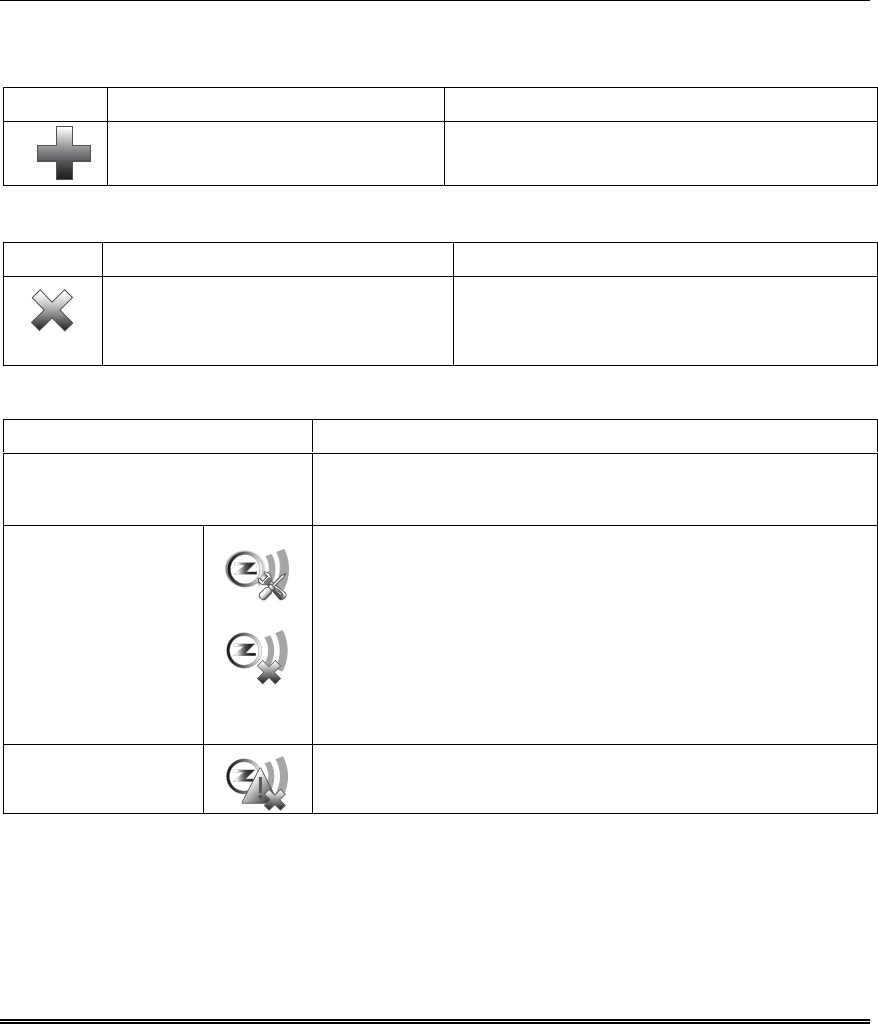
Automation (cont’d)
41
Updating Controllers with New or Removed devices
When devices are added or removed from the Z-Wave network, the device information needs to be
updated in the Controllers. To update this information, from the Primary controller, do the following.
ICON ACTION NOTES
1. Press Add on Primary controller.
2. Press Add on Secondary controller.
The controller scans for device changes.
The message is displayed:
“Devices added Successfully”
Removing a Secondary Controller
To remove the Secondary controller, do the following:
ICON ACTION NOTES
1. At the Primary Controller keypad:
a) Press Delete.
2. At the Secondary Controller keypad:
b) Press Delete.
Both keypads will display, “Device Removed” and the
Secondary Controller keypad will revert back to the
Primary Controller.
Z-Wave Troubleshooting
PROBLEM SOLUTION
Cannot add new device. Make sure Z-Wave device is within range of the keypad. You
may need to move device closer to the keypad. Refer to the Z-
Wave devices’ Instruction Guide for proper range.
Device is within
proper range but
still will not
include.
1. At the Tuxedo Touch Keypad:
a) Press the Automation icon from the “Home” screen and then
press the Z-Wave Setup icon to display the “Z-Wave Device
Management” screen.
b) If the device does not appear on the screen, press the Z-
Wave Exclude/Delete icon.
2. At the Z-Wave device, press the Function Key. The screen
will display a message “Device Removed”.
3. At the Tuxedo Touch Keypad:
a) Include device again.
Highlighted device
will not delete.
When deleting a device, if the selected device remains on the
screen, highlight the device name and press the Z-Wave
Removed Failed icon.

Automation (cont’d)
42
Compatible Devices
Z-Wave devices may vary; follow the instructions in the
Users Guide
for your specific device
when adding and deleting devices into the Z-Wave network.
Refer to the table below for some of the compatible devices.
Door Locks
Yale Real Living Push Button Lever Lock
Yale Real Living Touchscreen Lever Lock
Yale Real Living Push Button Deadbolt Lock
Yale Real Living Touchscreen deadbolt Lock
Schalge Link Deadbolt Lock
Schlage Link Lever Lock
Kwikset Smartcode Lever lock
Kwikset Smartcode Deadbolt Lock
Thermostats
Honeywell ECC
Wayne Dalton Zwave thermostat
Trane Zwave Thermostat
Appliance
HomeManageable Appliance Module
Wayne Dalton Small Appliance Module
GE wireless lighting control plug in appliance module
SOMFY
Lights
Leviton/ViziaRF+ switches
Leviton/ViziaRF+ dimmers
Leviton/ViziaRF+ plug in modules
GE wireless lighting control dimmers
GE wireless lighting control Switches
GE wireless lighting control plug in lamp modules
Not all features are supported for off-the-shelf Z-Wave devices.

43
Important Notes
For additional troubleshooting procedures, refer to the Control Panel Installation Guide.
General Notes
• You may check to see whether the Chime Mode is ON or OFF by viewing the keypad Operating
Modes screen as described in “Operating Modes” in Section 5 of the keypad Installation and Setup
Guide.
• Note that some displays on the keypad may not have enough space to display the whole name of a
partition. When this occurs, the display shows as many characters as possible starting at the
beginning of the partition name. We recommend that the partition name be kept to a maximum of
7 characters to ensure the “H” which indicates the home partition may be seen.
• “Exit Error” and “Auto Arm Alert, Please Leave Now” messages are not displayed by the keypad.
• When the system has 6150Vs or 6160Vs, and 6271Vs attached, the Additional Console setting in
the 6150Vs (displayed as A on the 6150V) must be set to 1 and the Additional Console setting in
the 6160Vs must be set to Yes.
Commercial System Notes
• If the Aux Relay function is set for alarm silenced by User Code + # + 67, this command may only
be entered in the console emulation mode.
• Do not use the common lobby logic function.
• If fields 2*22 (Display Fire Alarms of other Partitions), 2*23 (Display Burg & Panic of other
Partitions), or 2*24 (Display Troubles of other Partitions) are enabled, the zones that created the
conditions cannot be viewed. You must go to that zone's home partition to view.
• If field 1*11 (Zone Bypass After Disarm) is enabled, you must use the keypad’s Console Emulation
Mode and the commands “Code” + “64” (unbypass all) or “Code” + “6” + “Zone Number” (unbypass
zone) to remove zone bypasses.
• The First to Alarm Display Lock feature (field 1*10) is not supported by the keypad.
• RF Low Battery messages are not supported by the keypad except in the Show Zones screen where
a Battery Icon is displayed for the zone with the low battery.
Residential System Notes
• If the Clean Me option is set, when the maintenance signal is received a “Fire Maintenance”
message and the Display Faults icon is shown. However, if you display the faults, zone 1 is not
shown as a faulted zone.
• If RF Jam Reports are selected and RF Jam is detected, the User Authorization screen displays
“Trouble ZN100 RF Receiver”. If you enter the console emulation mode, the display shows “Check
90 RF Receiver Jam”.
• Do not use the Custom Word reminder feature.
User Related Notes
• Users added to the system using the keypad graphic user screen must be deleted from the keypad
using the graphic screen as well. Deleting users from the panel by any other means (alpha keypad,
console emulation mode, or Compass downloader) does not automatically delete them from the
keypad.

Important Notes (Cont’d)
44
• If the panel has exit tones enabled and you arm the system in the Away mode, the keypad beeps
continuously throughout the exit period.
Use the console emulation mode for the following functions:
- Programming more than 10 system users.
- Programming the Pager report option for users of residential control panels (e.g., VISTA-15P and
VISTA-20P).
- Special Function Key operations (such as macros or single-button paging).
- End-User Scheduling.
- To check for an “Alarm Cancelled” message if this feature has been enabled in the system.
Wireless Range
This device complies with the Z-Wave® standard of open-air, line of sight transmission distances of 100
feet. Actual performance in a home depends on the number of walls between the controller and the
destination device, the type of construction and the number of Z-Wave enabled devices installed in the
control network.
Please Note: Z-Wave home control networks are designed to work properly alongside wireless security
sensors, Wi-Fi, Bluetooth and other wireless devices. Some 900 MHz wireless devices such as baby cams,
wireless video devices and older cordless phones may cause interference and limit Z-Wave functionality.
Things to consider regarding RF range:
- Each wall or obstacle (such as refrigerator, big screen TV, etc.) between the remote and the destination
device will reduce the maximum range of 100 feet by approximately 25-30%.
- Brick, tile or concrete walls block more of the RF signal than walls made of wooden studs and drywall.
- Wall mounted Z-Wave devices installed in metal junction boxes will suffer a significant loss of range
(approximately 20%) since the metal box blocks a large part of the RF signal.
WARNING: NOT FOR USE WITH MEDICAL OR LIFE SUPPORT EQUIPMENT!
Z-Wave enabled devices should never be used to supply power to, or control the On/Off status or medical
and /or life support equipment.
Controlling Devices:
The features and functions that can be controlled vary by manufacturer and you will need to review the user
manual that was provided to determine capabilities of each device.
IMPORTANT: Honeywell is not responsible for property damages due to improper setting of the thermostat
modes.
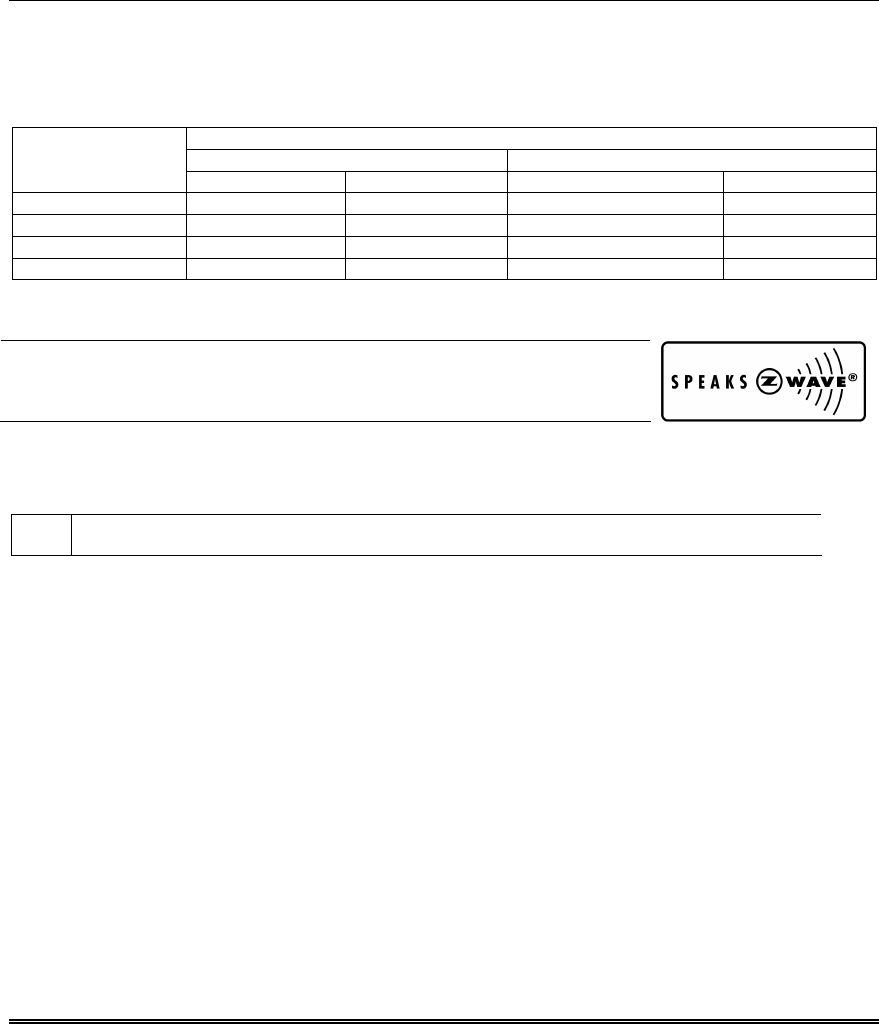
Important Notes (Cont’d)
45
Effects of Home Construction on Wireless Range between Z-Wave Enabled Devices
Note: The distances shown in the table below are typical examples. Actual performance in your home will
vary.
From the Remote (or repeating Z-Wave module) to the destination device:
Type of Construction
Wood Frame with Drywall Brick, Tile or Concrete
Number of Walls
or Obstacles Plastic J-Boxes* Metal J-Boxes Plastic J-Boxes* Metal J-Boxes
0** 100 ft 80 ft 100 ft 80 ft
1 70 ft 56 ft 60 ft 48 ft
2 49 ft 39 ft 36 ft 29 ft
3 34 ft 27 ft 21 ft 17 ft
* For Plug-in modules or in-wall devices installed in plastic junction boxes.
**Line of sight / no obstructions.
Z-Wave devices are identified by the Z-Wave logo and can be purchased from your local
retailer.
Z-Wave® is a registered trademark Sigma Designs, Inc. and/or its subsidiaries.
UL CO annunciation has not been investigated by UL and may not be used for UL installations.

FEDERAL COMMUNICATIONS COMMISSION STATEMENTS
The user shall not make any changes or modifications to the equipment unless authorized by the Installation
Instructions or User's Manual. Unauthorized changes or modifications could void the user's authority to operate the
equipment.
FCC CLASS B STATEMENT
This equipment has been tested to FCC requirements and has been found acceptable for use. The FCC requires the
following statement for your information:
This equipment generates and uses radio frequency energy and if not installed and used properly, that is, in strict
accordance with the manufacturer's instructions, may cause interference to radio and television reception. It has
been type tested and found to comply with the limits for a Class B computing device in accordance with the
specifications in Part 15 of FCC Rules, which are designed to provide reasonable protection against such
interference in a residential installation. However, there is no guarantee that interference will not occur in a particular
installation. If this equipment does cause interference to radio or television reception, which can be determined by
turning the equipment off and on, the user is encouraged to try to correct the interference by one or more of the
following measures:
• If using an indoor antenna, have a quality outdoor antenna installed.
• Reorient the receiving antenna until interference is reduced or eliminated.
• Move the radio or television receiver away from the receiver/control.
• Move the antenna leads away from any wire runs to the receiver/control.
• Plug the receiver/control into a different outlet so that it and the radio or television receiver are on different branch
circuits.
• Consult the dealer or an experienced radio/TV technician for help.
INDUSTRY CANADA CLASS B STATEMENT
ICES-003 Class B Notice - Avis NMB-003, Classe B
This Class B digital apparatus complies with Canadian ICES-003.
Cet appareil numérique de la classe B est conforme à la norme NMB-003 du Canada.
FCC / IC STATEMENT
This device complies with Part 15 of the FCC Rules, and RSS 210 of IC. Operation is subject to the following two
conditions: (1) This device may not cause harmful interference (2) This device must accept any interference
received, including interference that may cause undesired operation.
Cet appareil est conforme à la partie 15 des règles de la FCC & de RSS 210 des Industries Canada. Son
fonctionnement est soumis aux conditions suivantes: (1) Cet appareil ne doit pas causer d' interferences nuisibles.
(2) Cet appareil doit accepter toute interference reçue y compris les interferences causant une reception indésirable.
The Tuxedo Touch WIFI must be installed to provide a separation distance of at least 7.8 in. (20 cm)
from all persons and must not be co-located or operating in conjunction with any other antenna or
transmitter except in accordance with FCC multi-transmitter product procedures.
For the latest warranty information, please go to:
www.honeywell.com/security/hsc/resources/wa

2 Corporate Center Drive, Suite 100
P.O. Box 9040
Melville, NY 11747
Copyright © 2011 Honeywell International Inc.
www.honeywell.com/security
Ê800
Ê800Ê800
Ê800-
--
-103006Š
103006Š103006Š
103006Š
800-10300 11/17/11 Rev. A BETA
For Online Support visit:
http://www.security.honeywell.com/hsc/resourses/MyWebTech